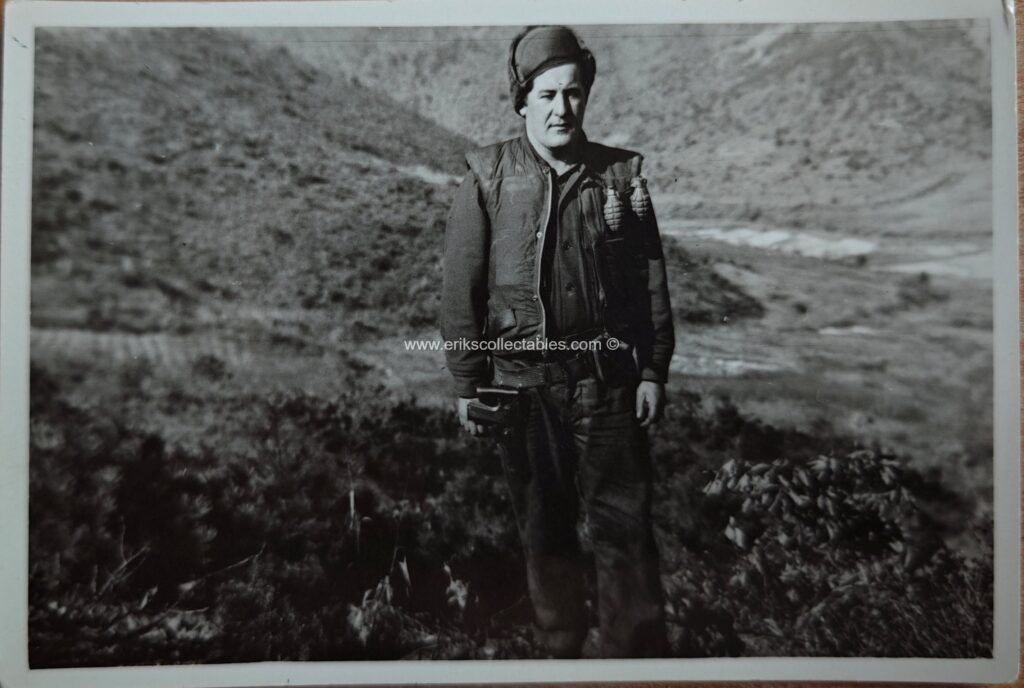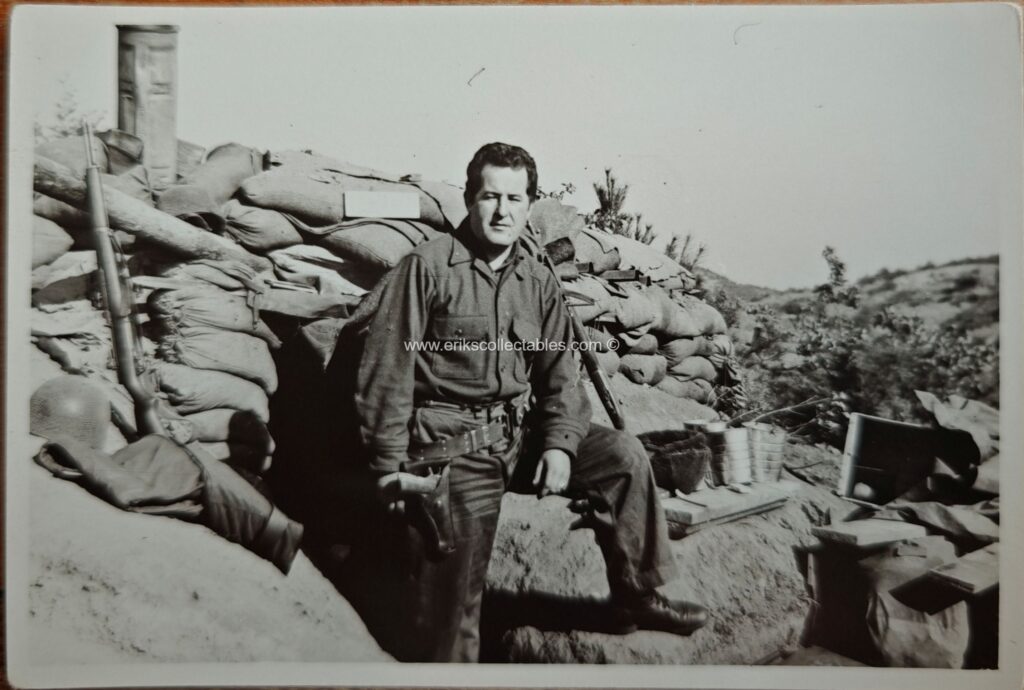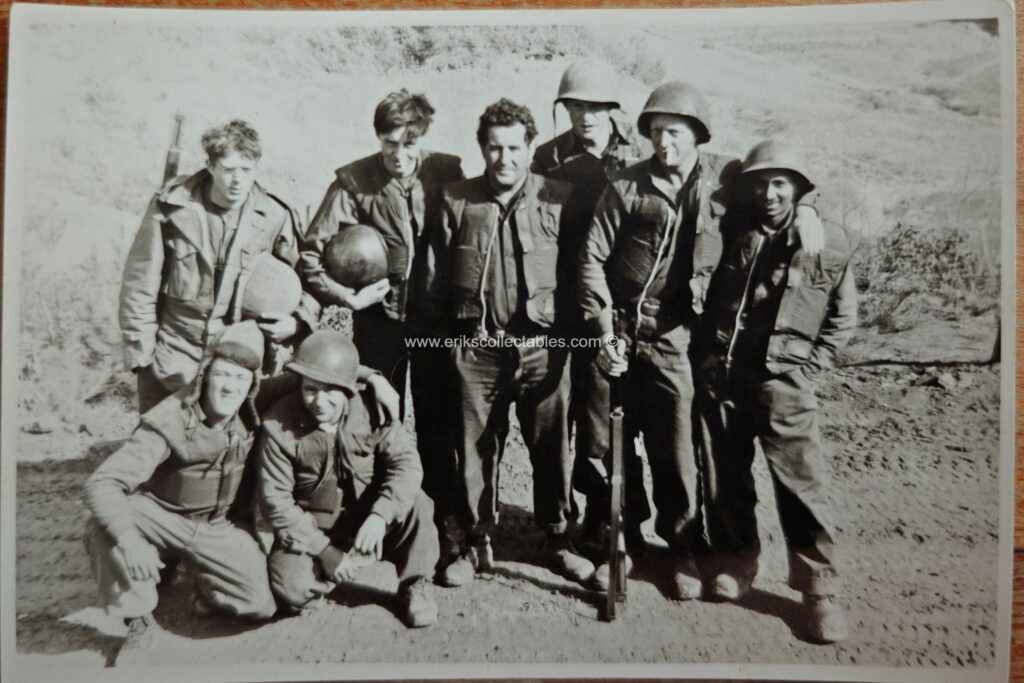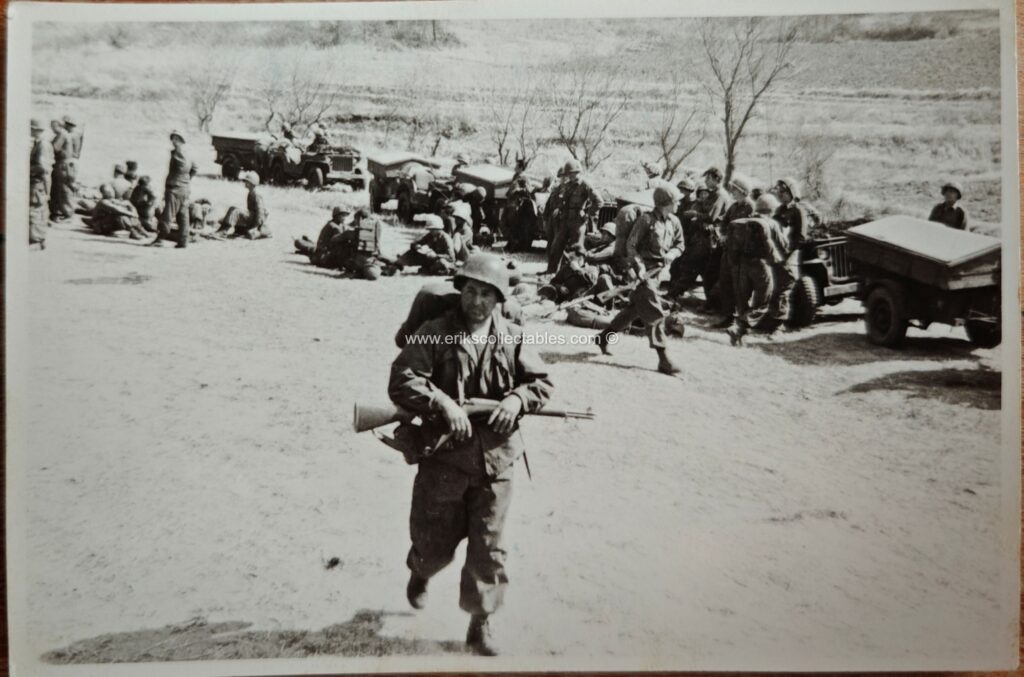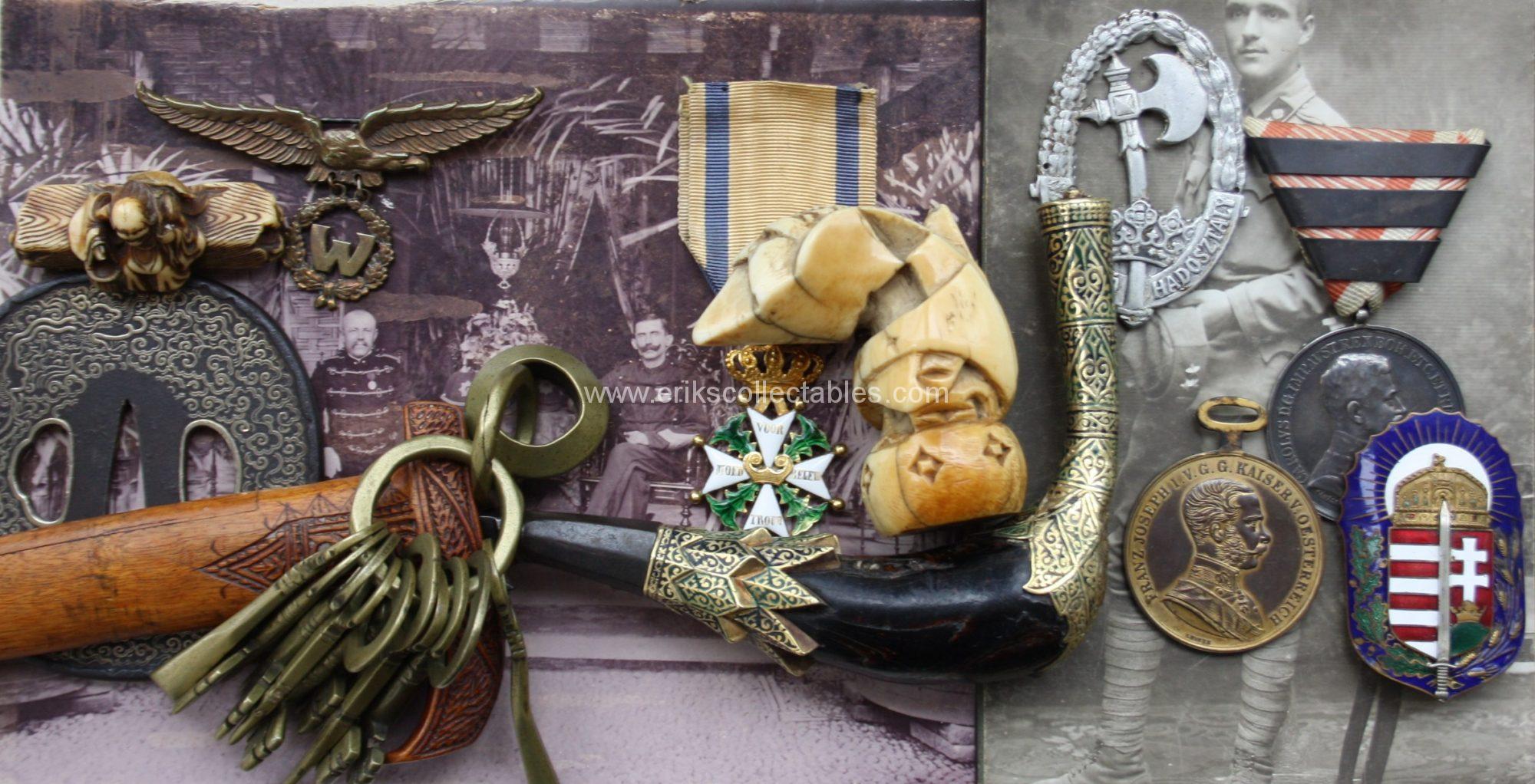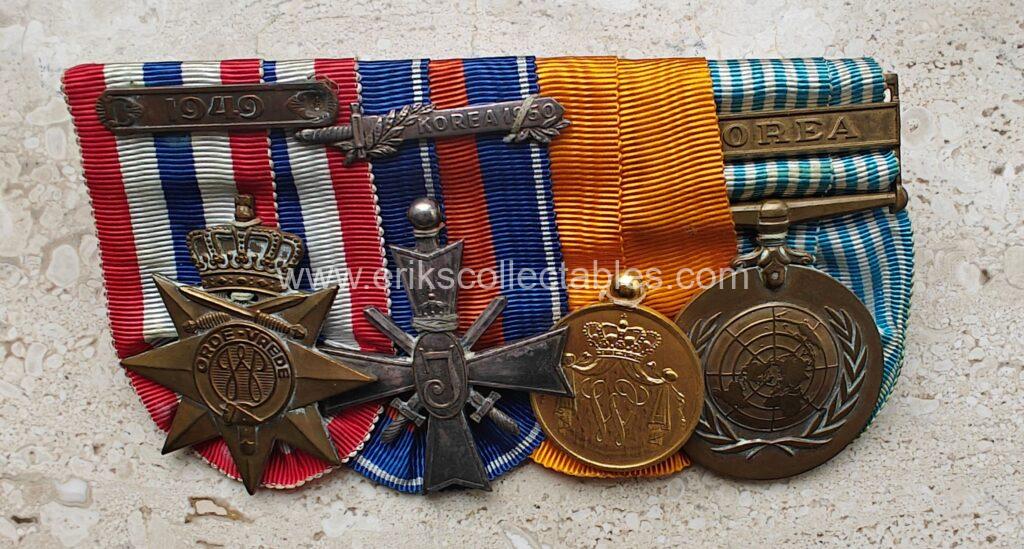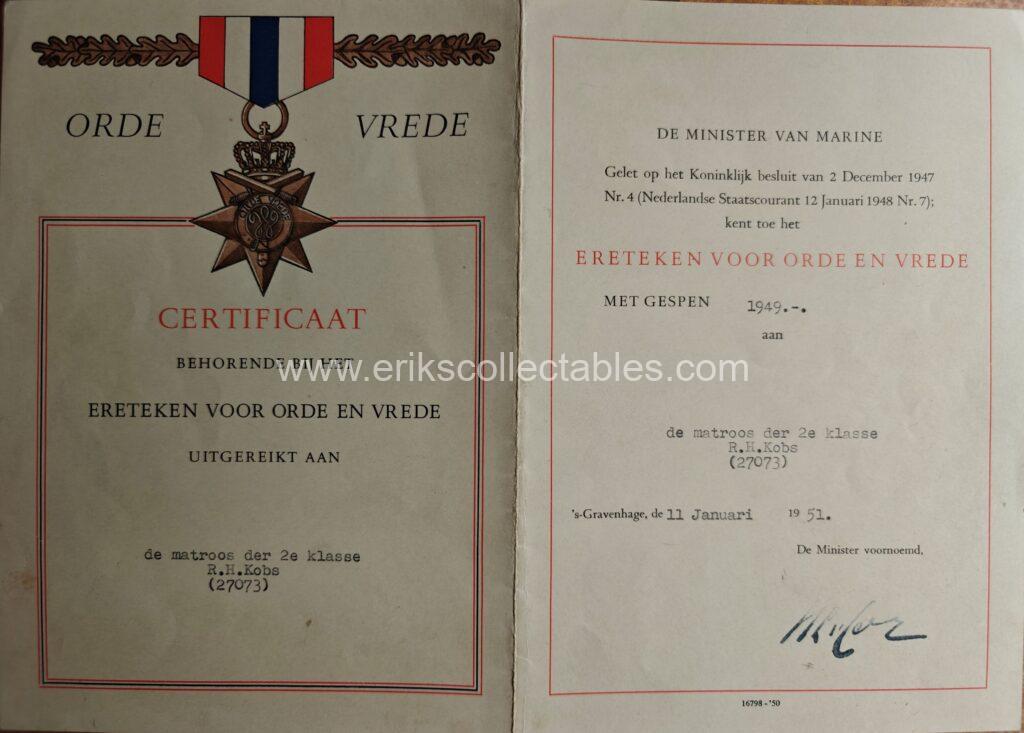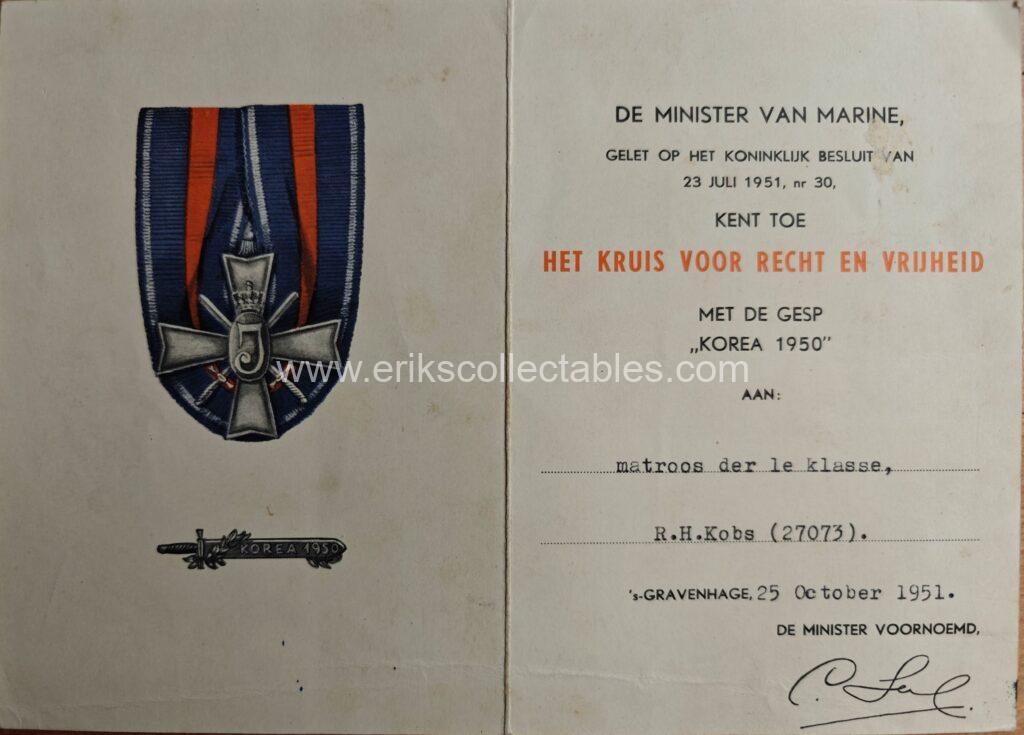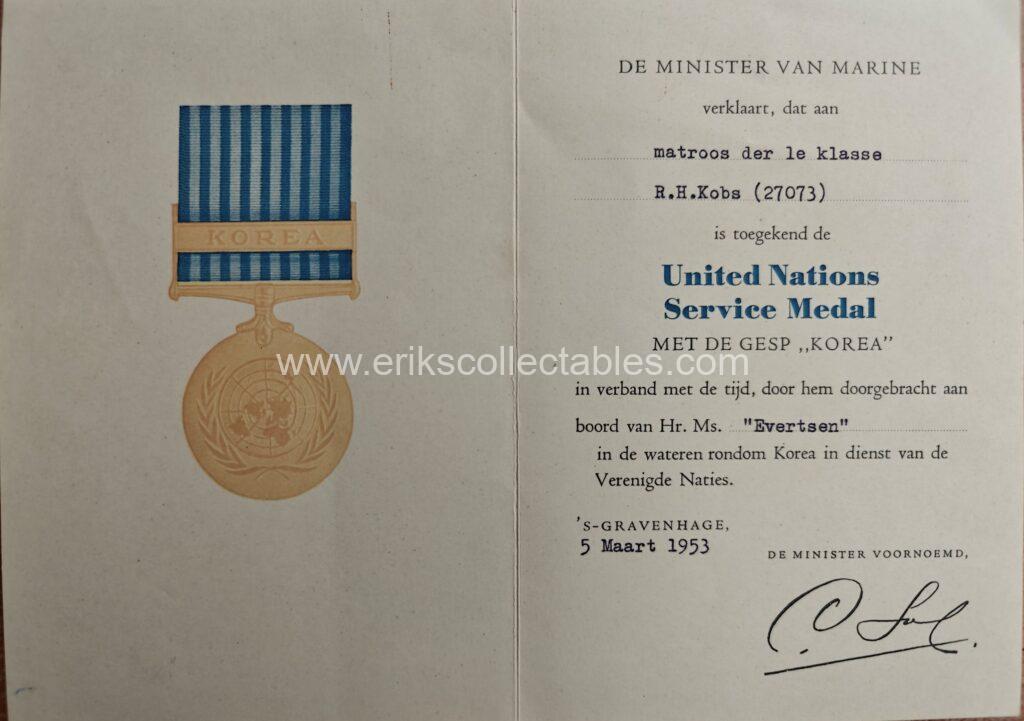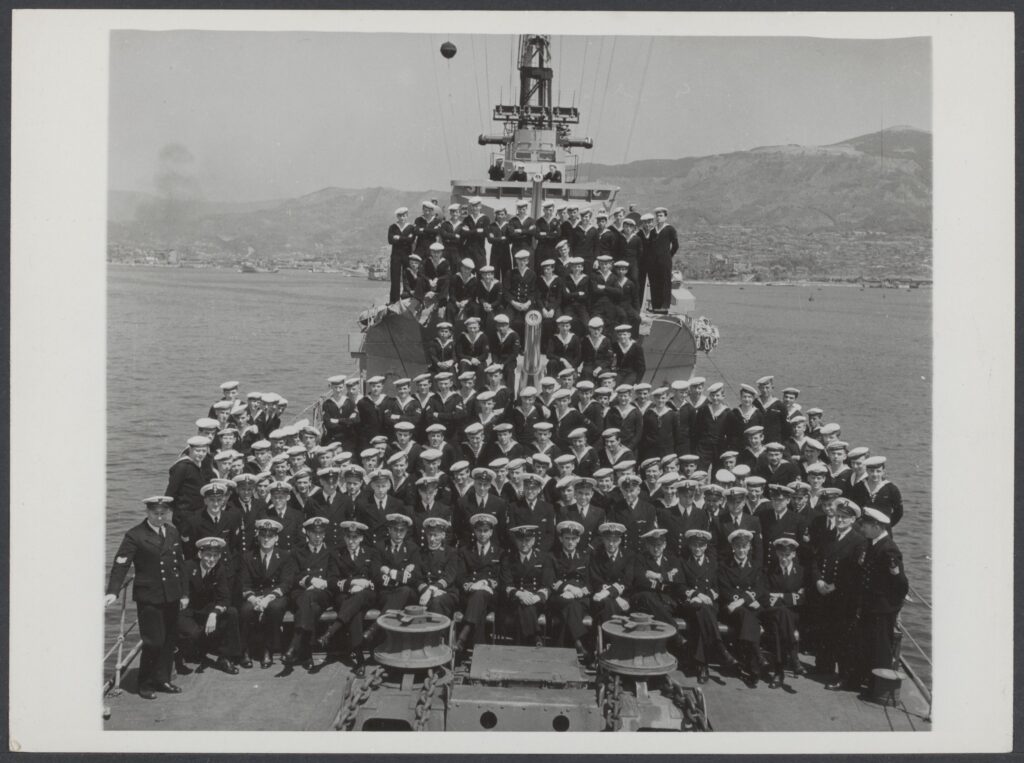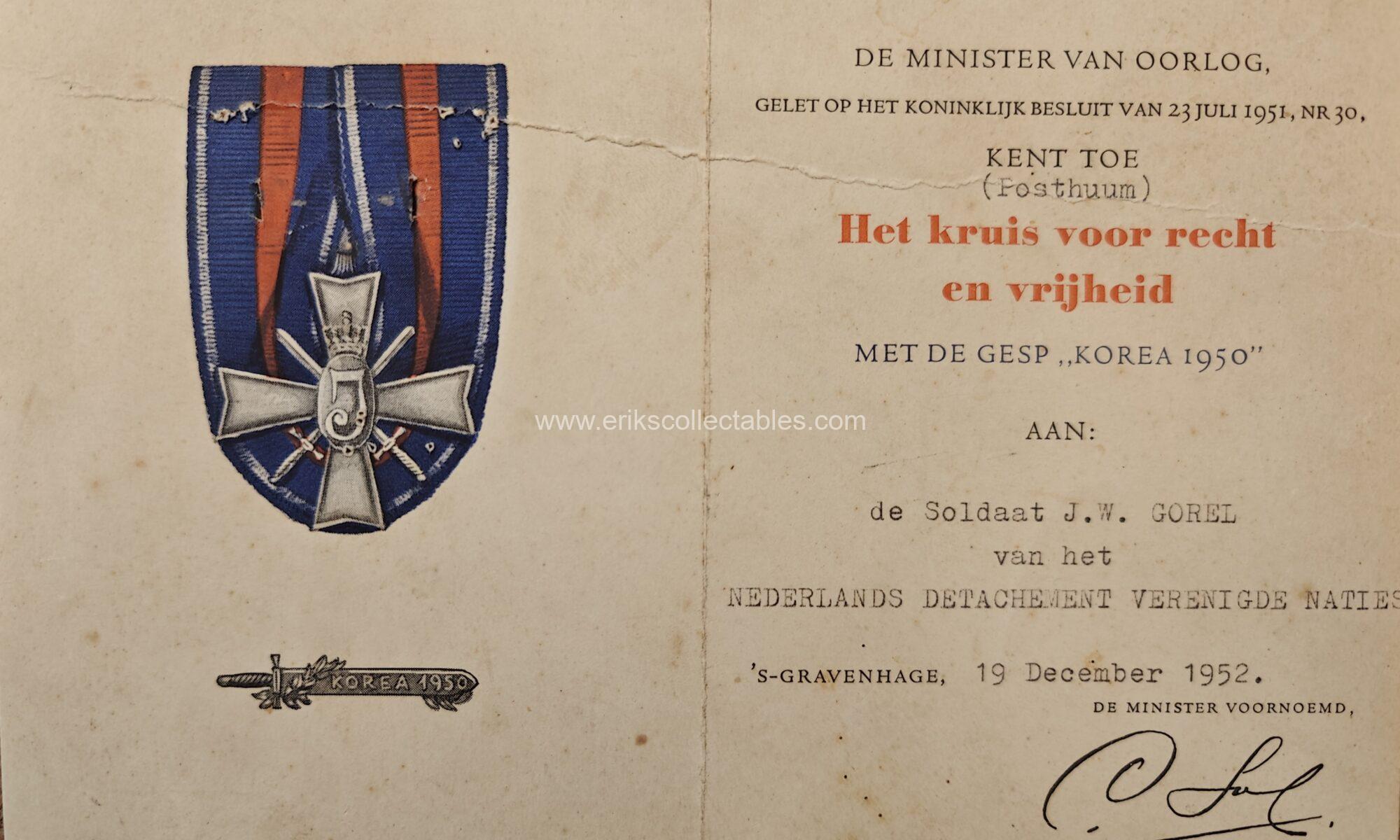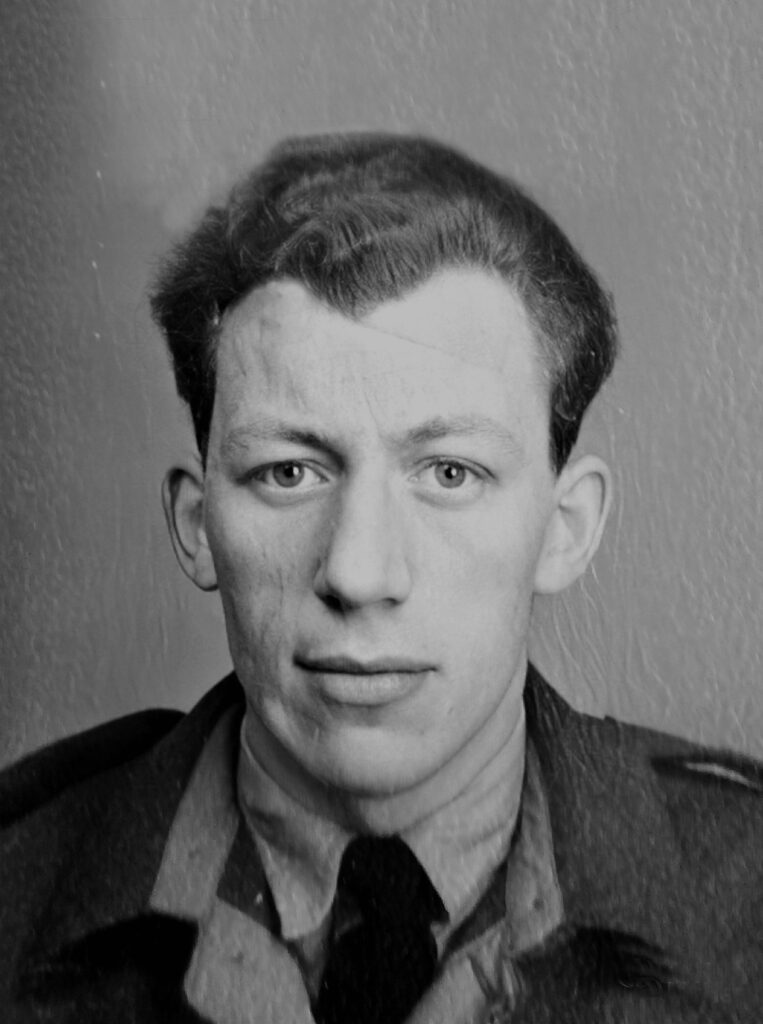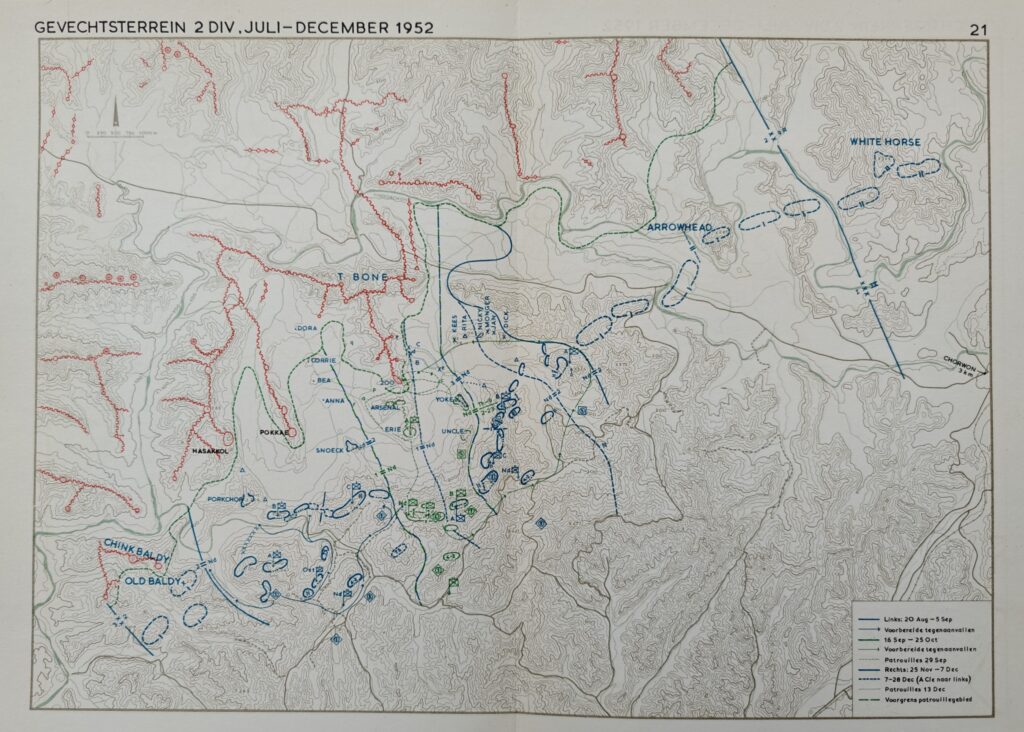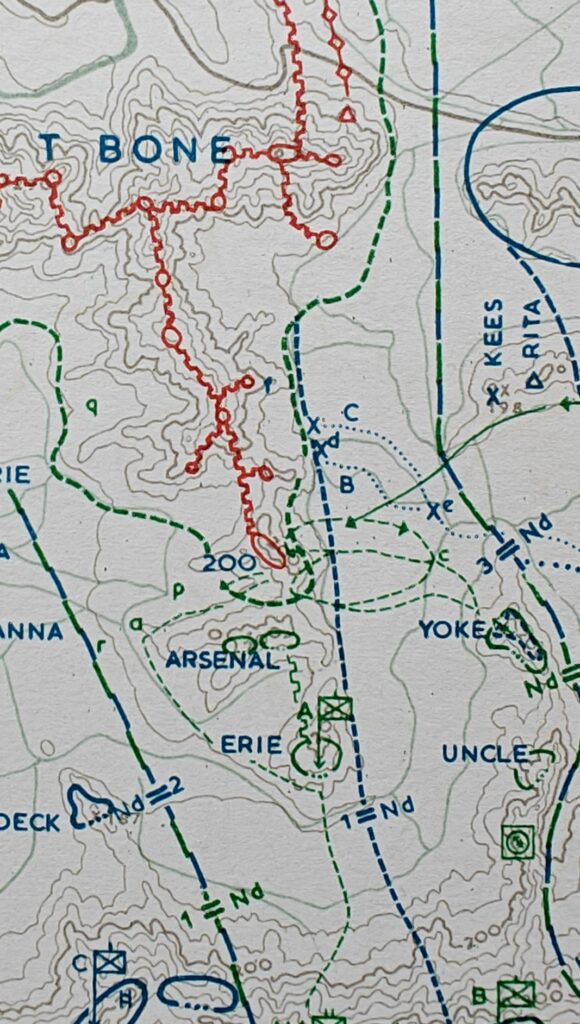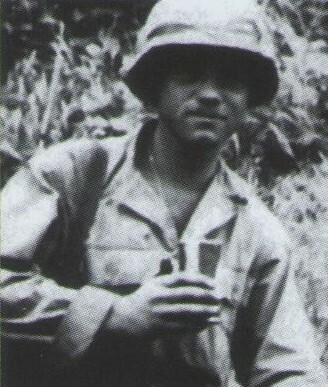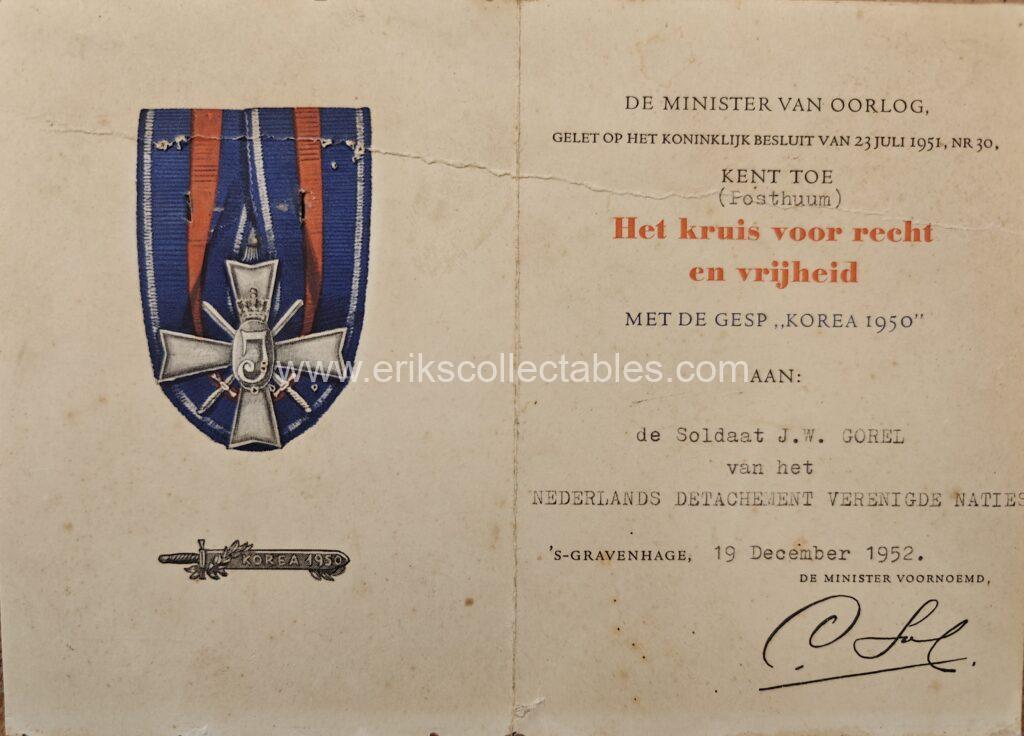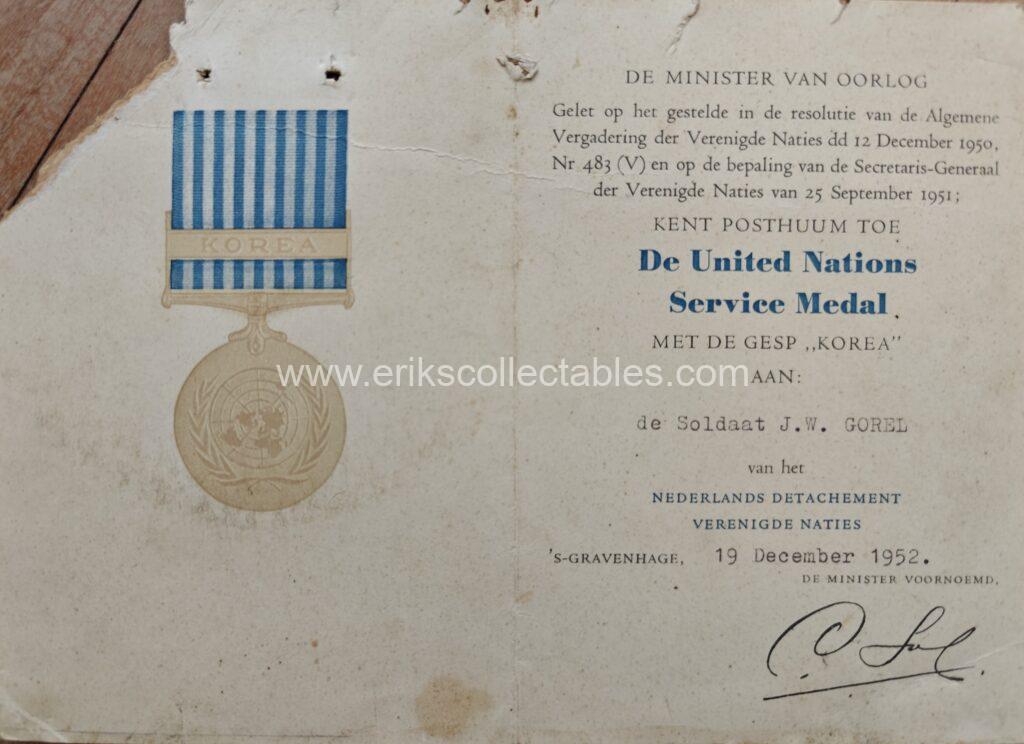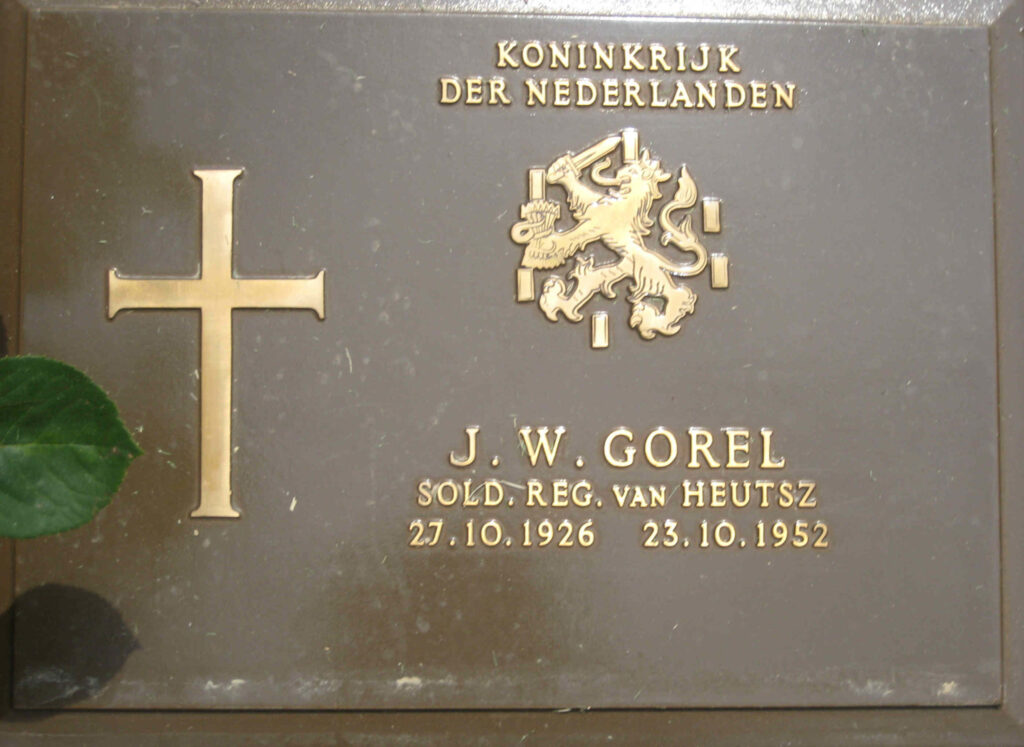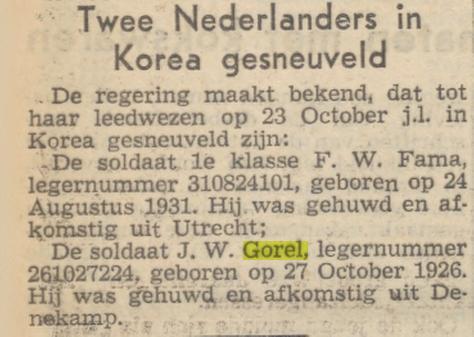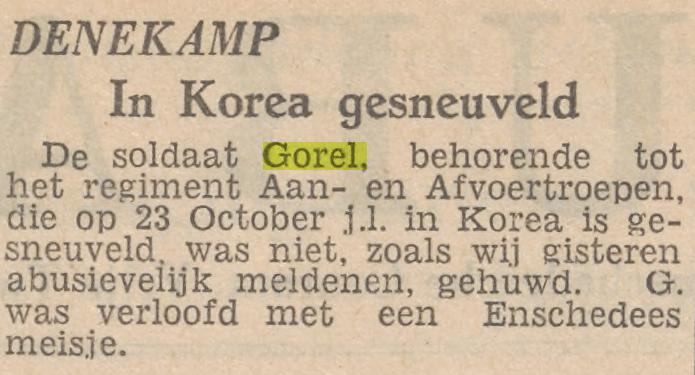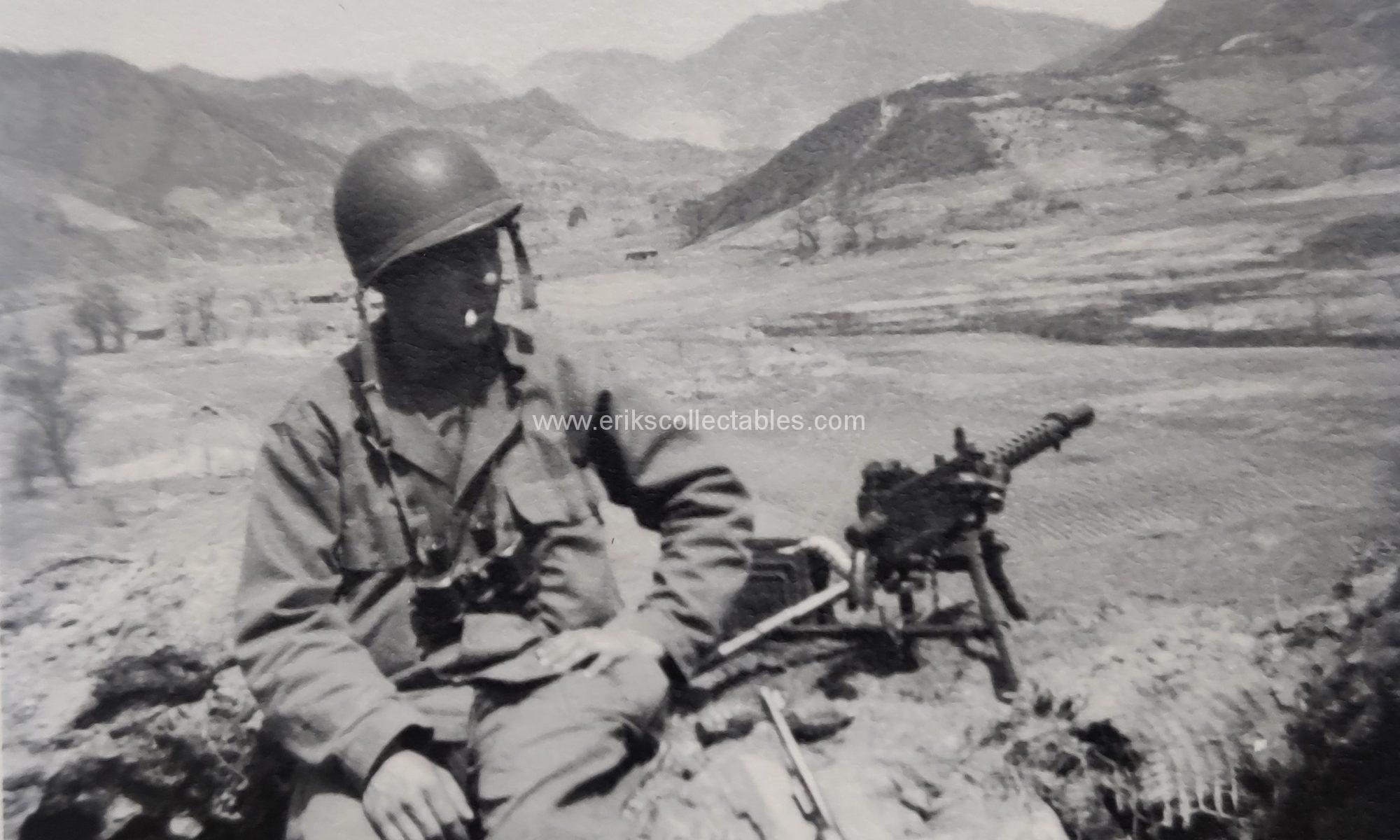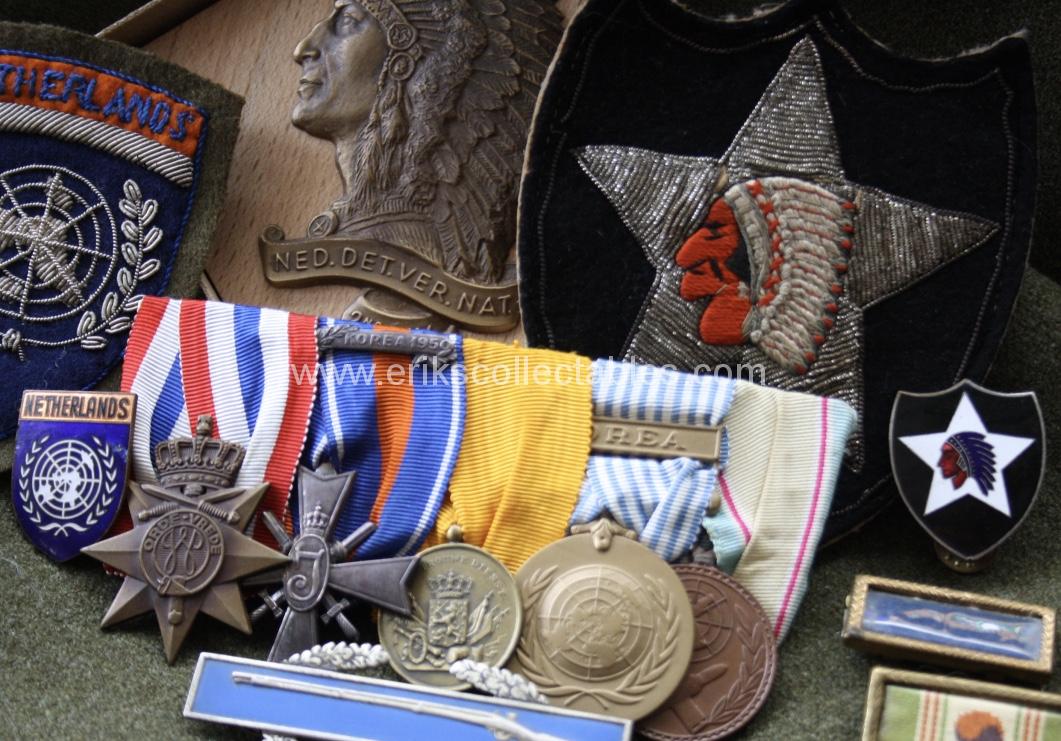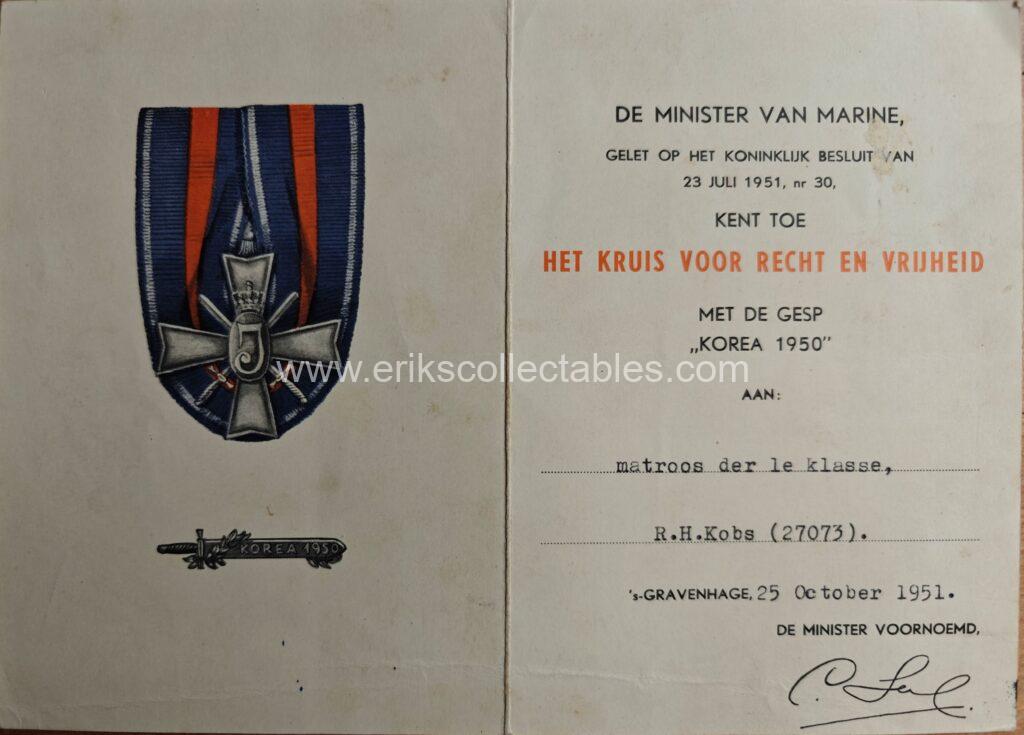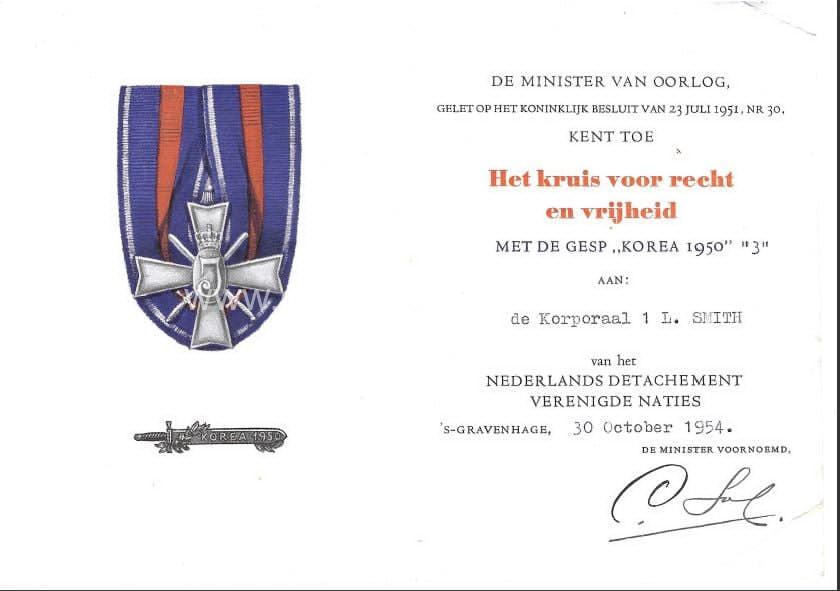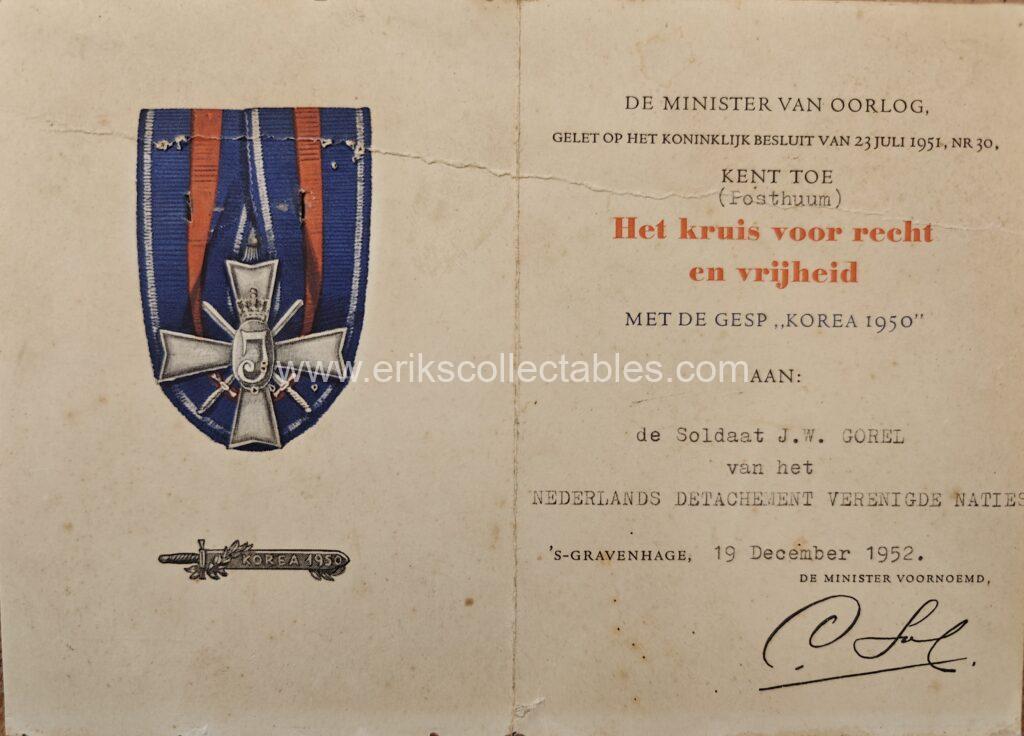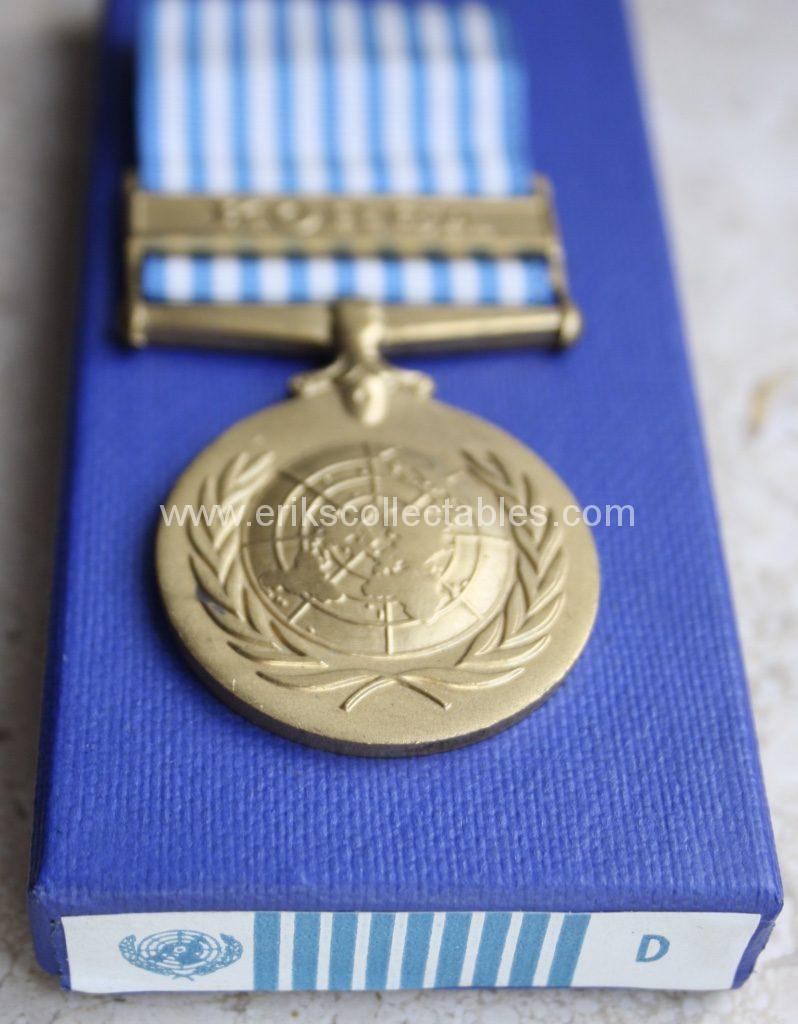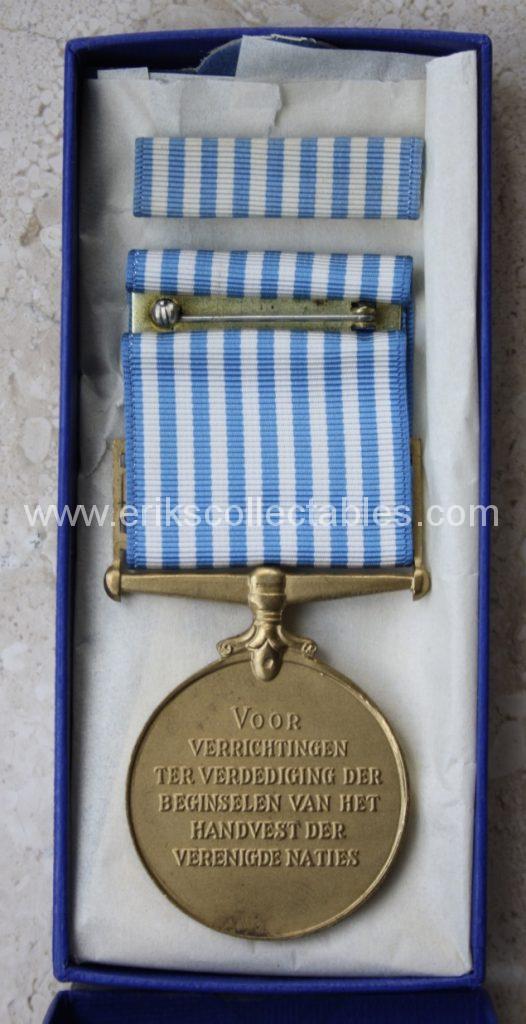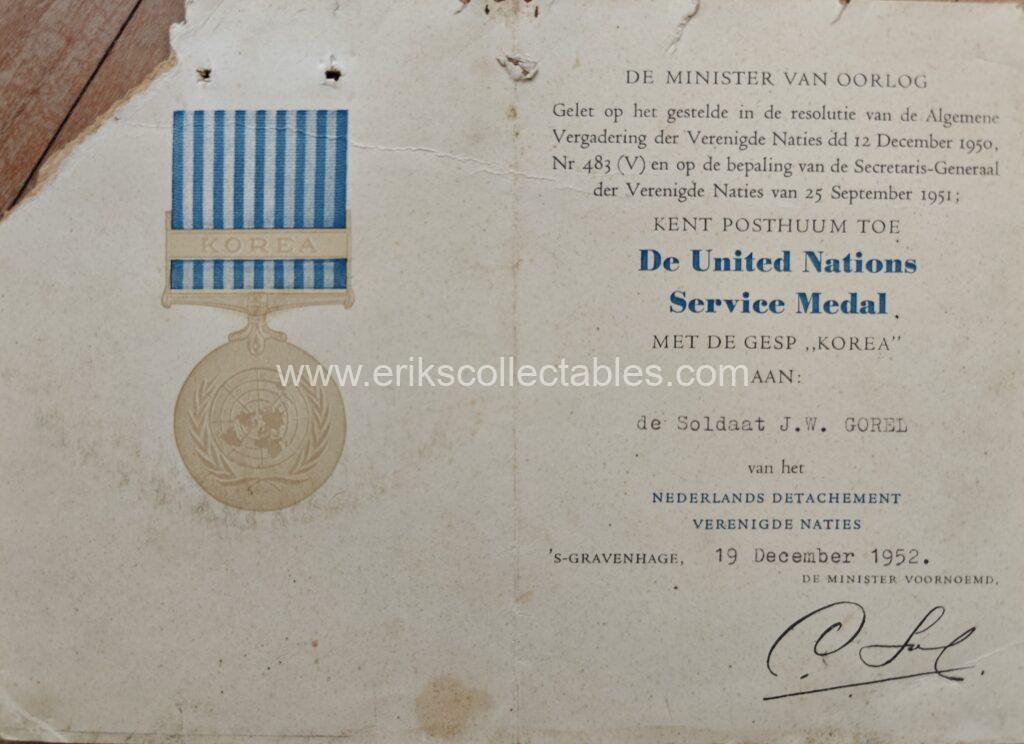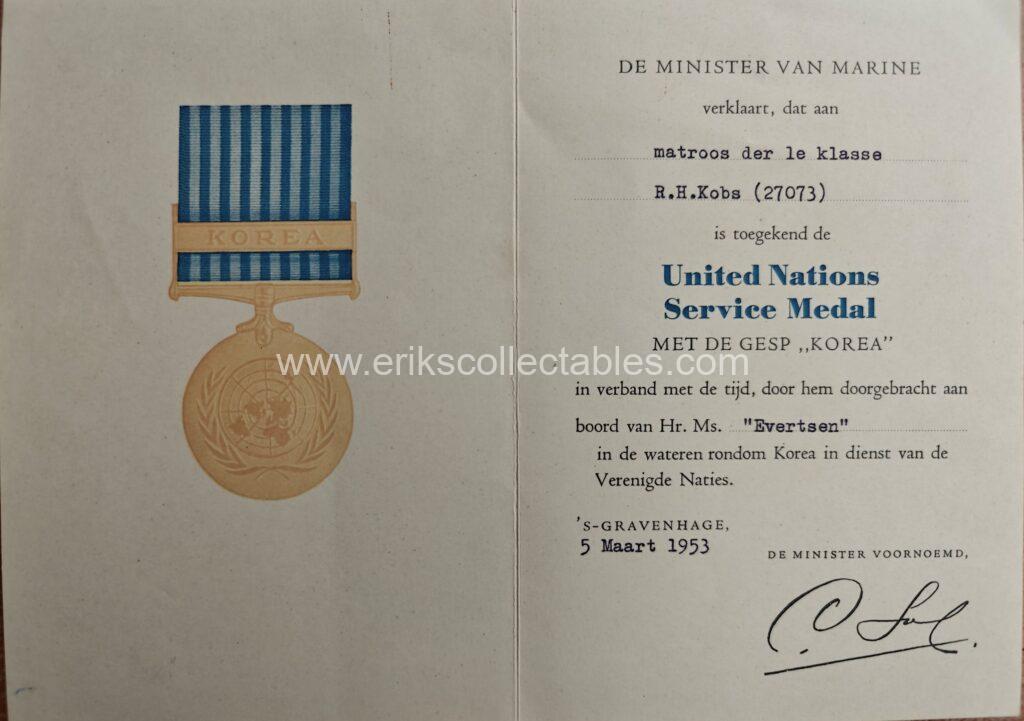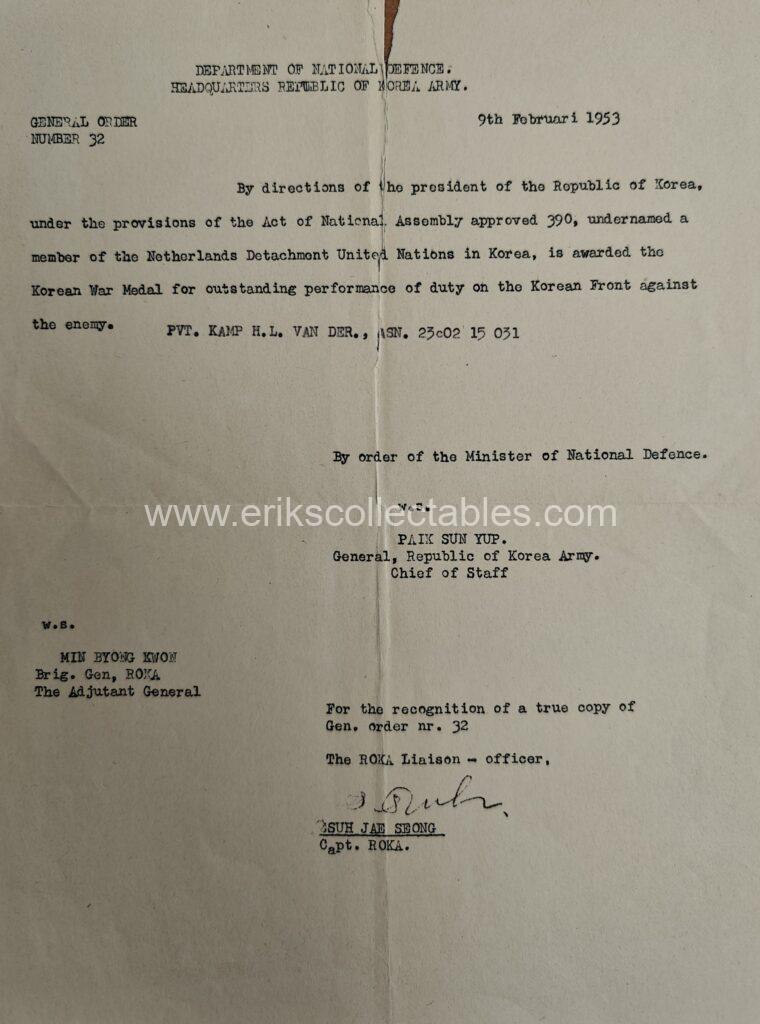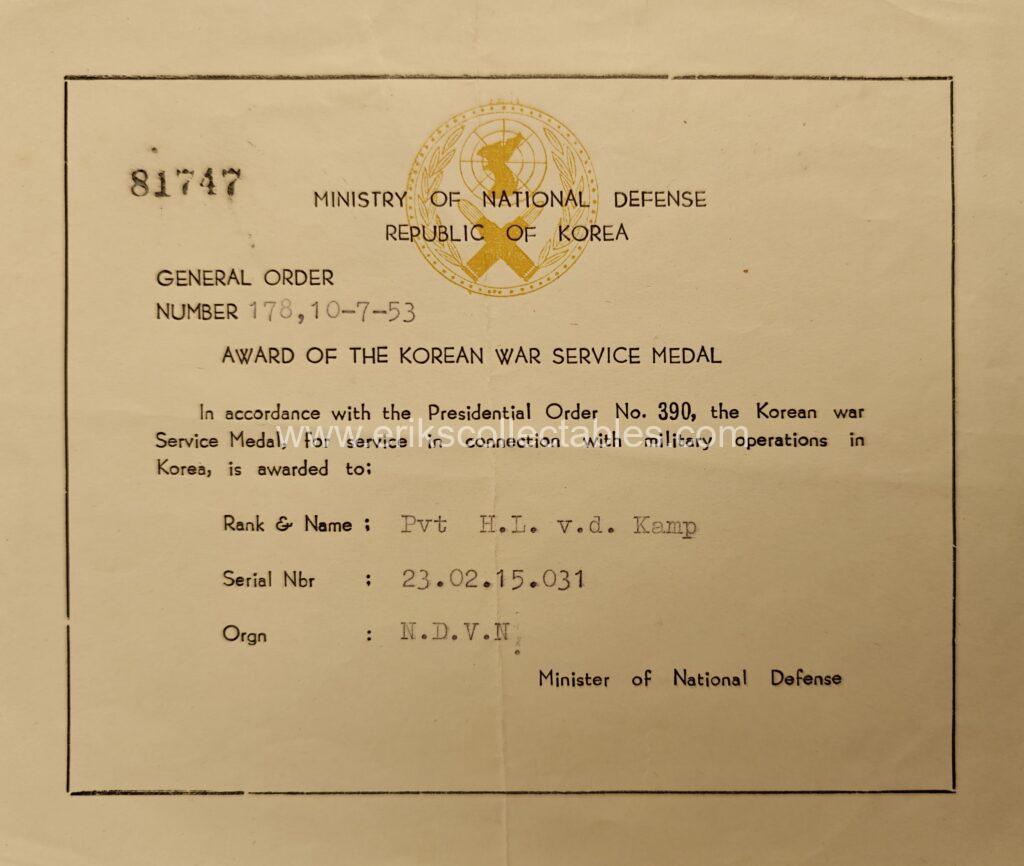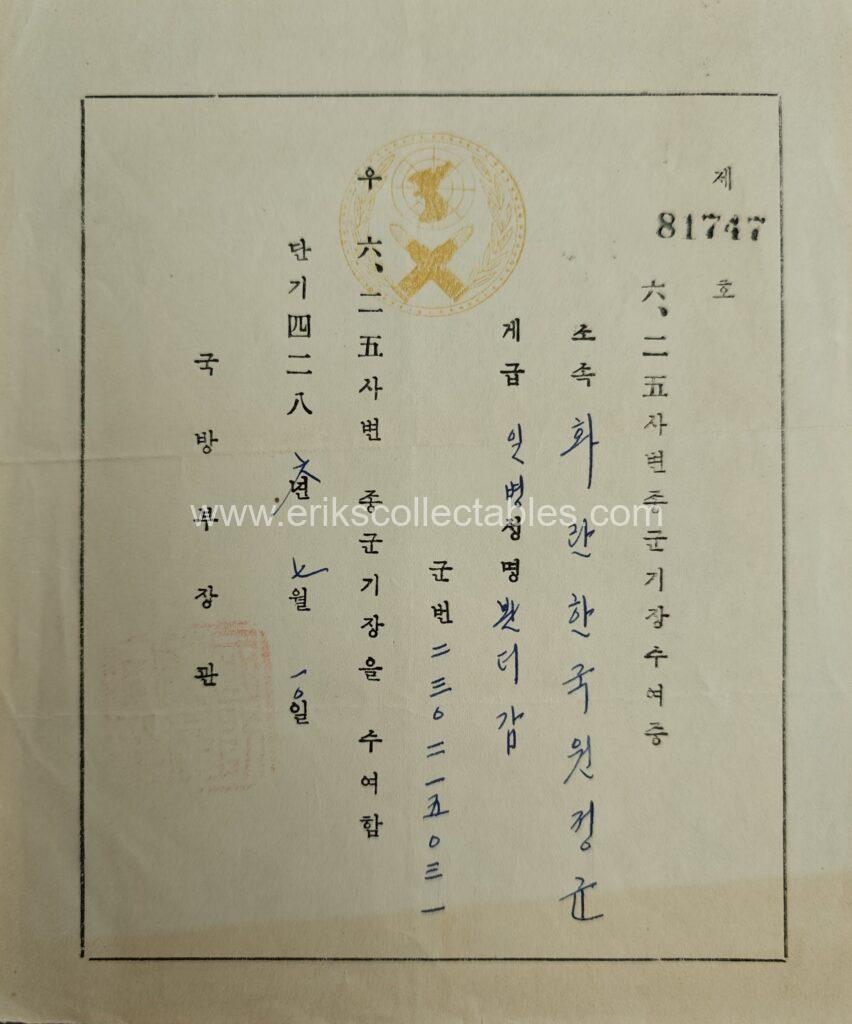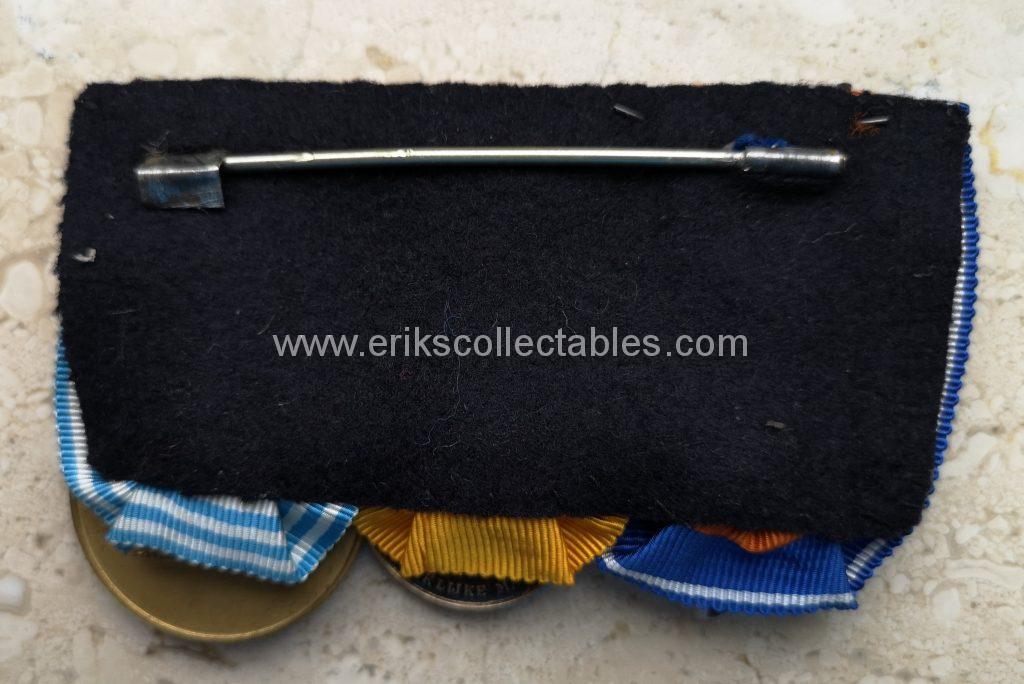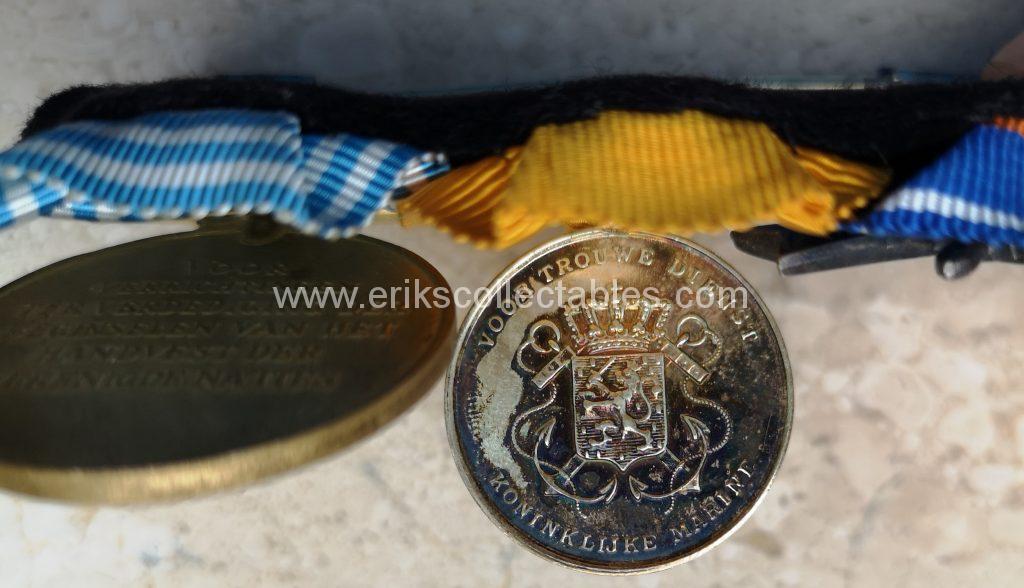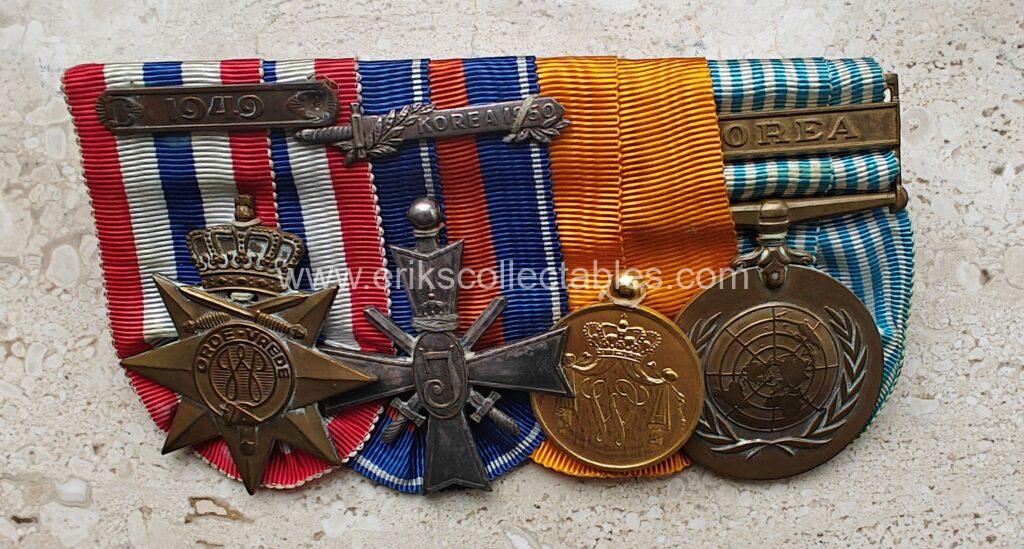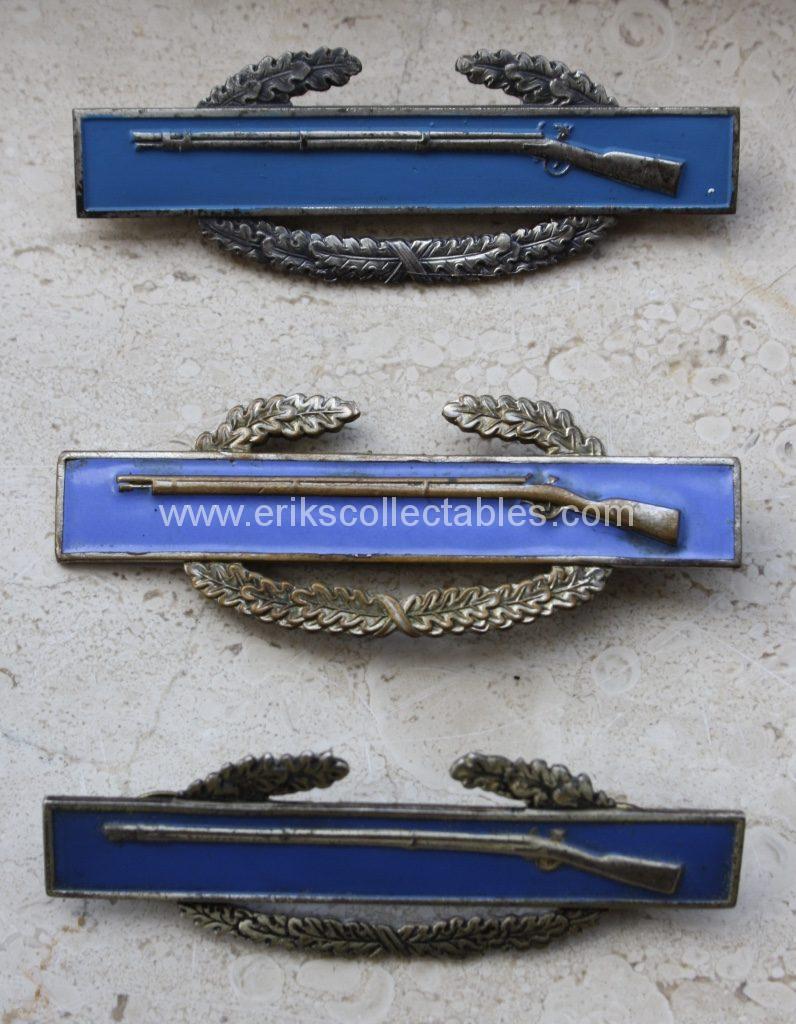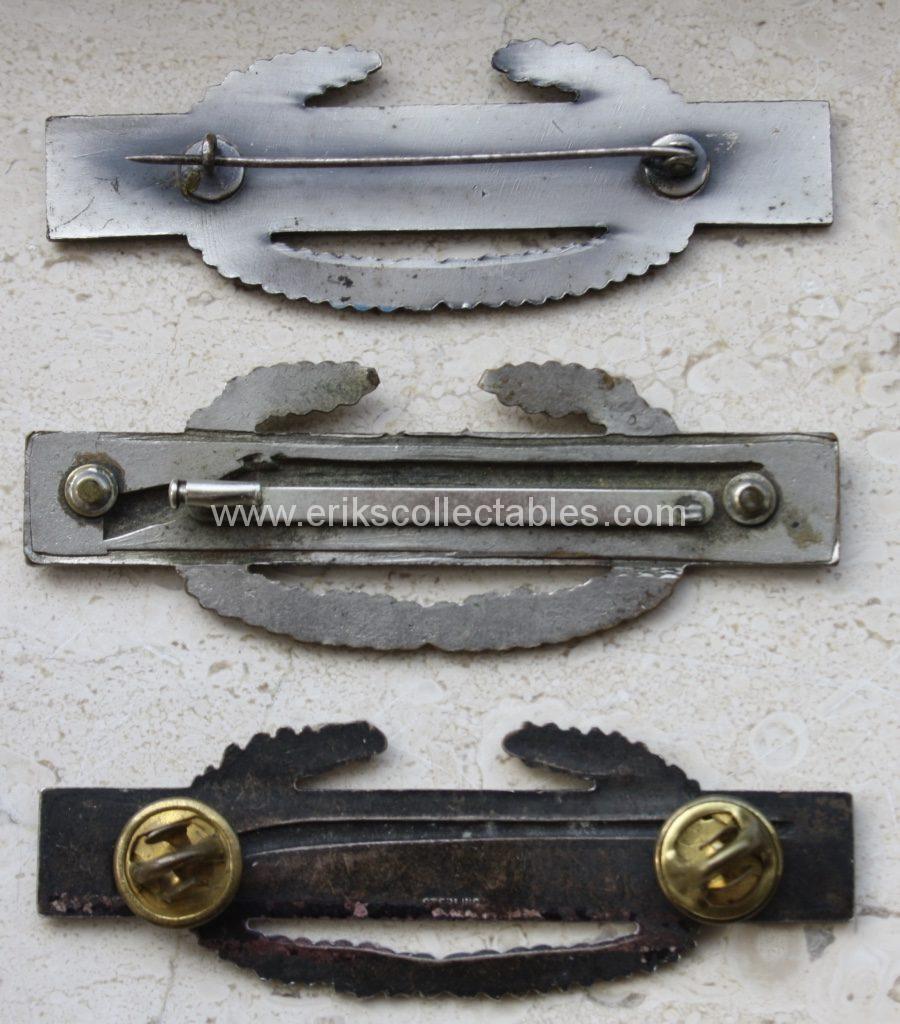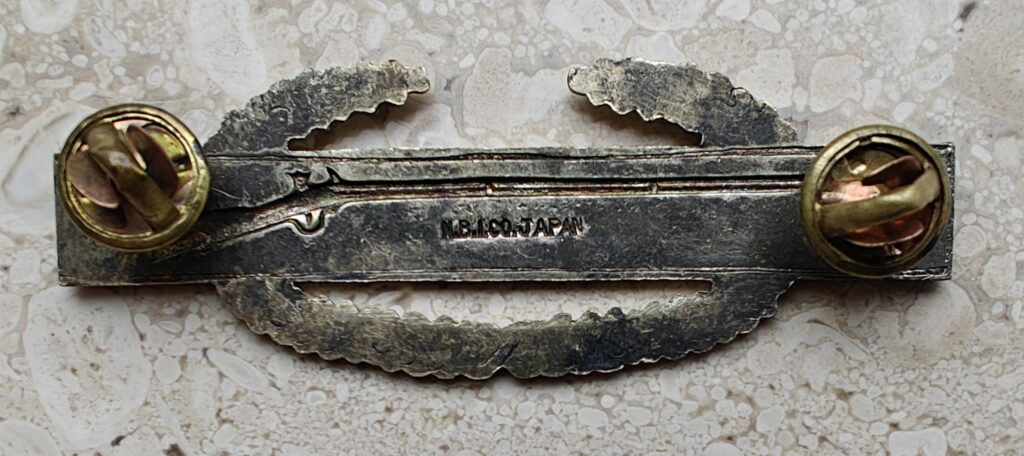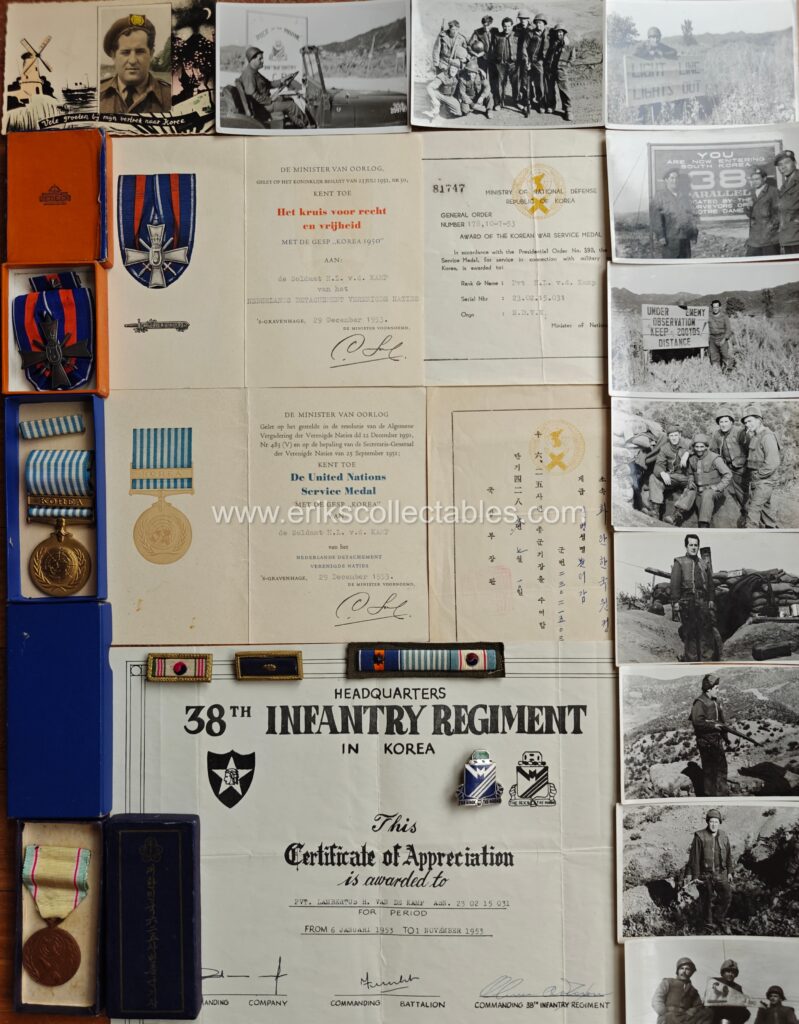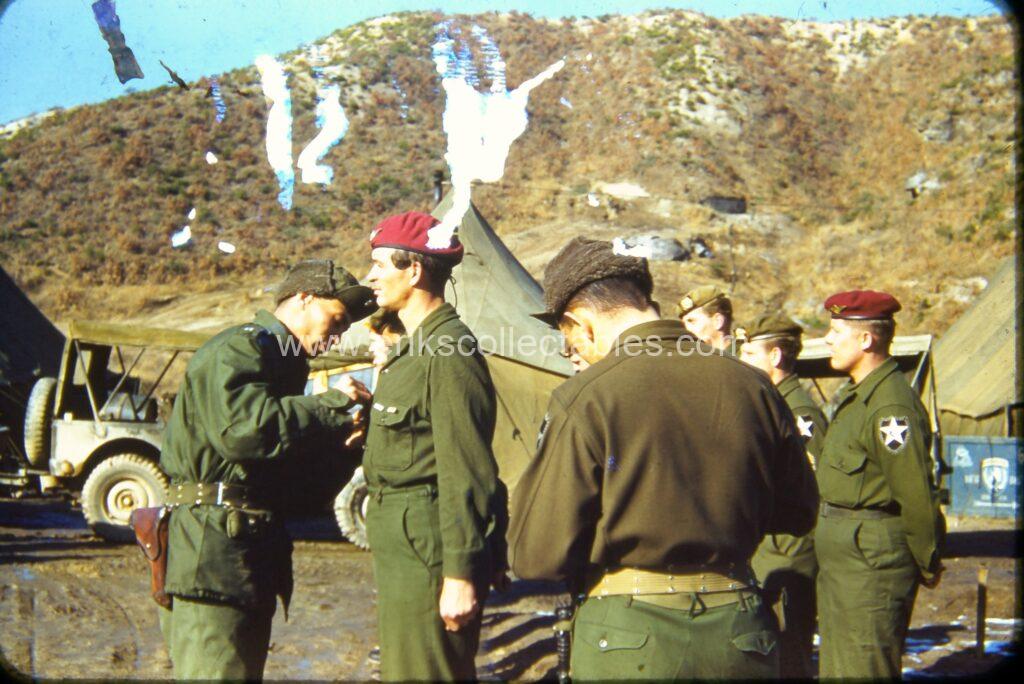Iedere Korea groep aan een Nederlander is bijzonder. Het aantal militairen dat deelgenomen heeft aan het Nederlandse Detachement Verenigde Naties (NDVN) is relatief klein en over iedere periode vallen bijzonderheden te vermelden. Dit is de groep voor een deelnemer die begin 1953 in Korea aankwam, soldaat Van de Kamp.
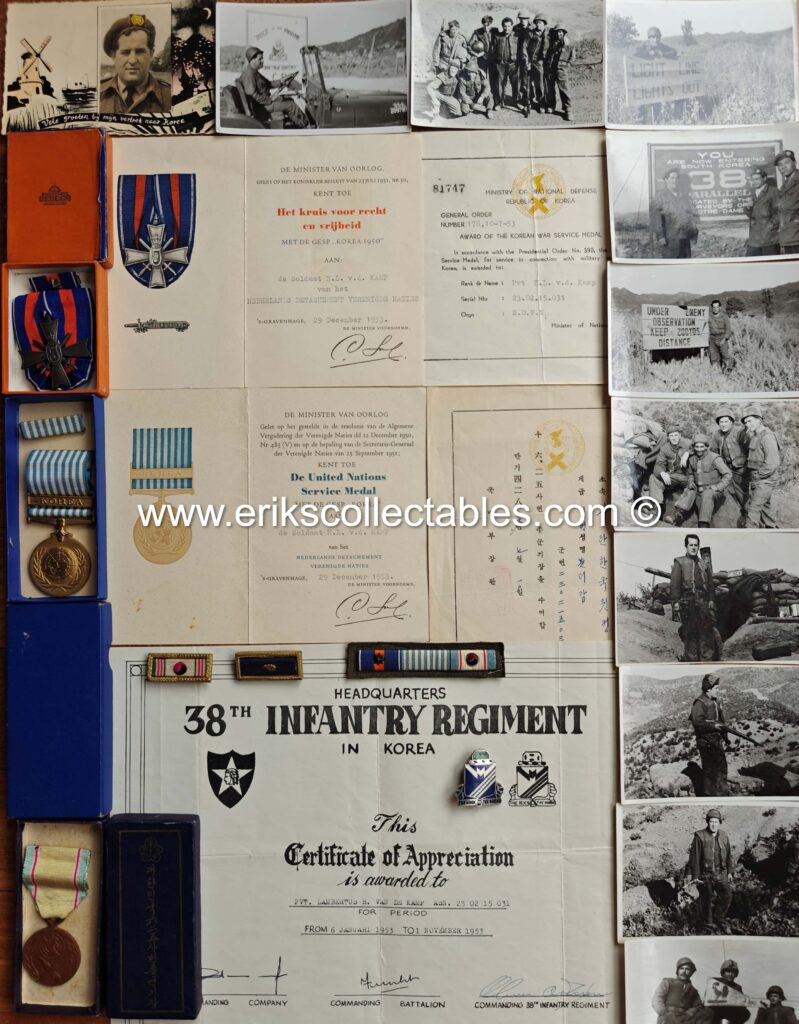
Medailles, papierwerk en foto’s van Van de Kamp
Dit zijn de nadagen van de Korea oorlog maar dat betekent niet dat er niets gebeurt. In de eerste helft van 1953 vallen nog 21 dodelijke slachtoffers bij het NDVN en wordt er nog actief patrouille gelopen in de frontgebieden. Daarom wordt door de Amerikanen (waar de Nederlanders onder vallen) de Combat Infantryman Badge verleend aan Van de Kamp voor daadwerkelijke frontdienst.

Voor vertrek en in Korea, de impact lijkt te zien op de foto’s
Sinds het begin van de strijd in Korea heeft Nederland het lastig om voldoende gekwalificeerde mannen te vinden voor dienst in deze nieuwe oorlog. Gaandeweg worden de eisen die voor de eerste groep zeer hoog lagen aangepast en komt een bredere groep mannen in aanmerking om deel te nemen. Ook het verleden van vrijwilligers wordt gaandeweg minder belangrijk in de toelating.
Hoewel het hier om een relatief “standaard” Korea groep gaat wat betreft de medailles is ook hier iets bijzonders aan de hand. Bij nadere bestudering van de gegevens viel de leeftijd van de man op, hij was 29 bij aanmelding en hij werd 30 na 2 maanden in Korea. Dit was ook de grensleeftijd voor vrijwilligers maar in de praktijk zeldzaam, zeker voor een gewone soldaat zonder specifieke militaire ervaring of expertise. Ondanks zijn hogere leeftijd had hij geen ervaring in 1940 bij de Duitse inval (te jong) en hij werd ook niet na de oorlog uitgezonden naar Indië.
De relatief hoge leeftijd en het ontbreken van eerdere (Nederlandse) dienstervaring is aanleiding te gaan kijken of er misschien een verleden is in Duitse dienst om deze late deelname als vrijwilliger te verklaren.
Er zijn namelijk inmiddels meerdere publicaties over Nederlanders met een verleden in Duitse dienst tijdens de tweede wereldoorlog die later alsnog dienst doen in Korea. (Valk & Hoogenboom oa). Waar dit thema vroeger al vaker genoemd werd is er inmiddels ook onderzoek gedaan en zijn er voorzichtige schattingen gemaakt. Valk noemt een aantal van onder de 100 militairen met een Duits dienstverleden voor Korea dus het verschijnsel lijkt relatief zeldzaam.
Dit onderzoeken kan in het Nationaal Archief en dan specifiek in het Centraal Archief voor Bijzondere Rechtspleging (CABR). Na de oorlog was er bijzondere rechtspleging die speciaal gericht was op de grote groep Nederlanders met een collaboratie en/of Duitse dienst verleden. Mensen werden onderzocht en waar van toepassing veroordeeld bij speciale rechtbanken.
Dit CABR archief is sinds enige tijd te raadplegen met enige beperkingen. Online bleek de naam van deze militair in het archief voor te komen op twee plekken wat duidt op een onderzoek en een veroordeling. Bij de daadwerkelijke inzage in de stukken van dit archief bleek dan ook een deel van het antwoord te vinden.
Hij wordt onderzocht en uiteindelijk in 1947 ook gestraft. Zijn eigen verslag is de belangrijkste bron van informatie met daarnaast enkele getuigenverslagen die erg beperkt zijn. Er zijn geen verdere bewijsstukken wat in veel andere dossiers wel het geval is. Een korte samenvatting van het relaas zoals in het archief aangetroffen is volgt hieronder. Dit is gebaseerd op de aantekeningen die ik gemaakt heb (fotograferen is niet toegestaan).
In 1941 wordt Van de Kamp 18 jaar maar kan geen werk vinden in Nederland. In Duitsland is er wel werk en dat wordt vanuit Nederland gefaciliteerd (Arbeitseinsatz) in zowel vrijwillige als onvrijwillige vorm. Van de Kamp kiest hier zelf voor en komt te werken bij een fabriek in Oranienburg waar meer Nederlanders werken. Na een verlof in Nederland meldt hij zich te laat bij zijn werk waardoor hij ontslagen wordt. Daarna volgt er een tijd van diverse omzwervingen in Duitsland en Oostenrijk inclusief de opname in een militair hospitaal (wederom volgens eigen verklaring en zonder bewijsstukken!). Uiteindelijk keert hij terug naar Nederland en wordt hij opgeleid tot vrachtwagenchauffeur (te Deventer, 6 weken opleiding).
Deze opleiding van het Duitste verkeersministerie is voor het opleiden van vrachtwagen chauffeurs voor met name het NSKK. Hij wordt met andere chauffeurs naar Parijs gebracht om van daaruit vrachtwagens naar Polen te vervoeren.
In mei 1944 sluit hij zich aan bij de Franse ondergrondse en blijft werken als chauffeur maar nu van een Franse officier in de rang van kapitein. Dit doet hij tot oktober wanneer hij naar Tilburg vertrekt, zijn geboorteplaats en de woonplaats van zijn ouders, dat dan net bevrijd is.
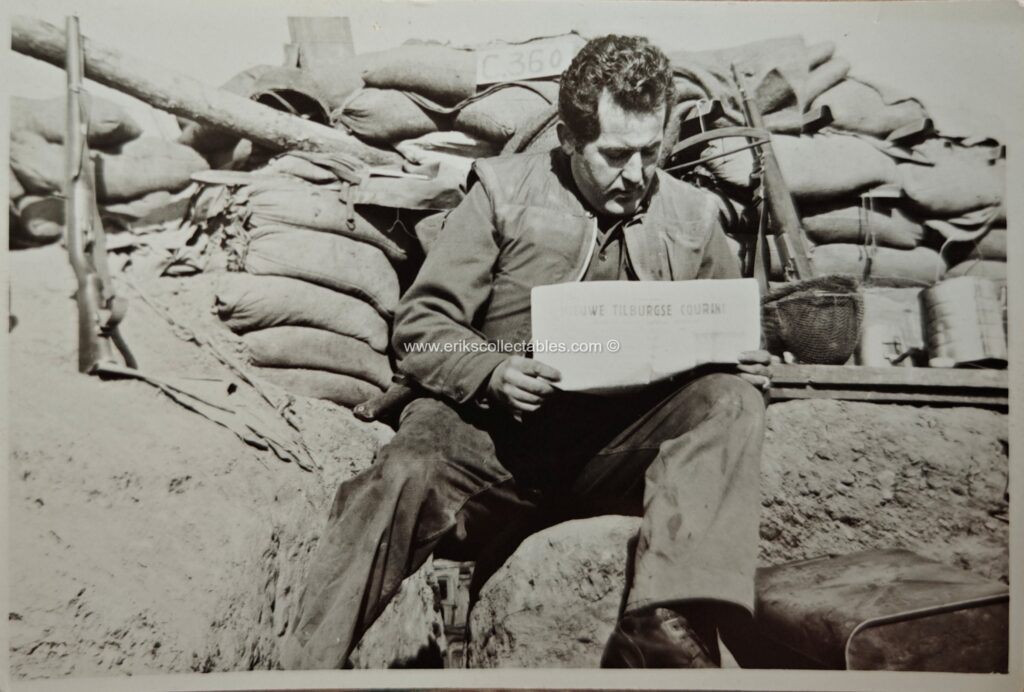
Van de Kamp met de Tilburgse Courant!
Daar gaat hij wederom aan de slag als chauffeur, nu voor de Binnenlandse Strijdkrachten en draagt dan een geallieerd uniform. Dit wordt door diverse getuigen bevestigd in het dossier. De getuigen verklaren dat ze hem in Duitsland in Oranienburg hebben zien werken (niet in uniform) en dat ze hem in Nederland in geallieerd uniform hebben gezien. Over de tussenliggende drie jaren inclusief zijn tijd als chauffeur zijn geen getuigenverklaringen en ook geen andere bewijsmiddelen naast zijn eigen verklaringen.
Wel wordt nog specifiek vastgelegd in het onderzoek dat terug te lezen is in het dossier dat hij geen bloedgroepteken heeft. Dit is een verwijzing naar de bloedgroep tatoeage die veel Waffen SS militairen onder hun oksel hadden.
Hij wordt voorwaardelijk buiten vervolging gesteld voor zijn oorlogsverleden maar met een proeftijd van 3 jaar, ingaande op 8 april 1947, en een ontzegging van 10 jaar in een aantal rechten waaronder het dienen bij de gewapende macht. Een relatief milde straf. Dit is vaker terug te zien bij mannen die geen lid waren van een politieke organisatie (zoals de NSB) maar in het buitenland actief waren voor de Duitse macht.
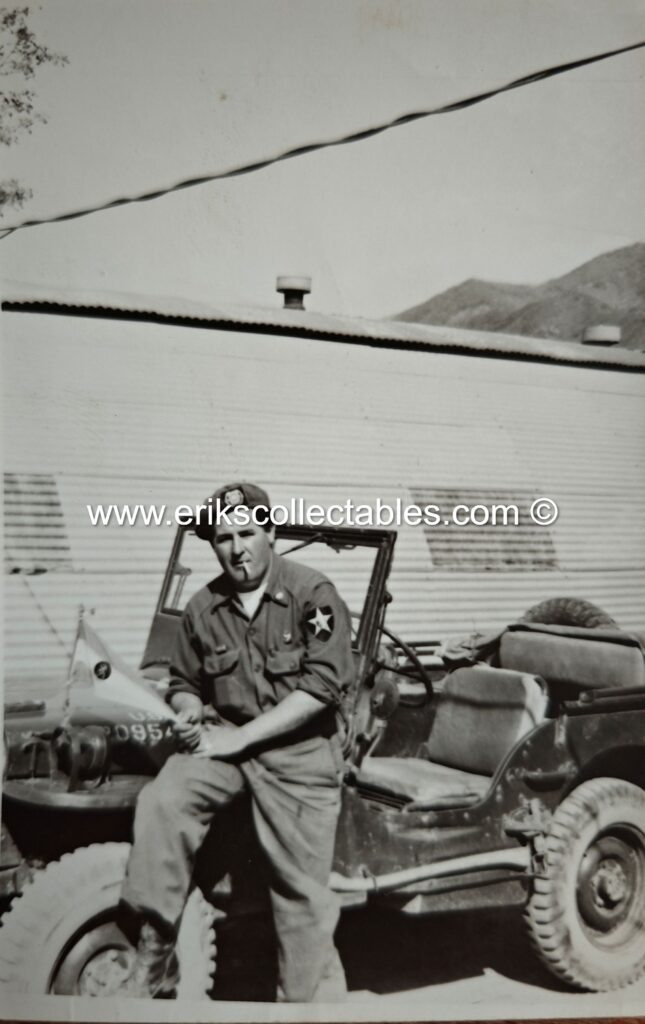
Infanterist maar ook weer chauffeur in Korea?
Het feit dat hij januari 1953 naar Korea gaat laat zien dat de uitspraak met betrekking tot het 10 jaar niet mogen dienen in de gewapende macht niet nagekomen is. Politiek delinquenten, zoals deze gestraften genoemd werden, bleven onder toezicht staan. Mogelijk werd hem vanuit het toezicht aanbevolen om deel te nemen aan het NDVN. Het was voor hem in ieder geval een kans om zich maatschappelijk te rehabiliteren. Hoe het precies gelopen is valt nu niet meer vast stellen. Van de Kamp overleed in 2017.
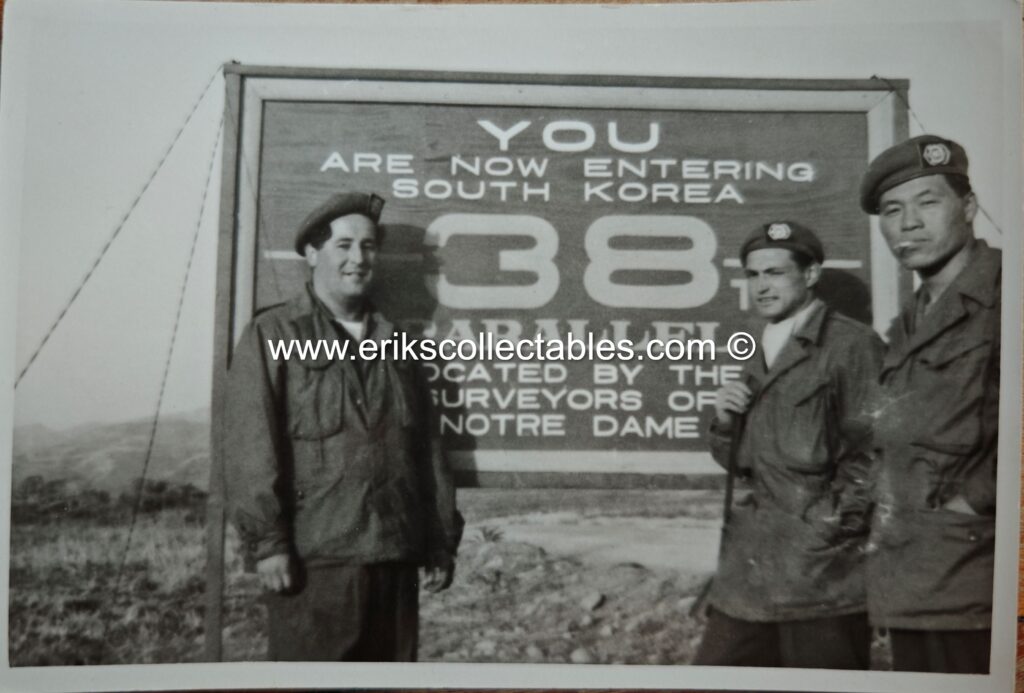
Bij de 38e breedtegraad met collega’s.
Het boek “Vechten voor vijand en vaderland” van Gerrit Valk laat zien dat het mogelijk was door de mazen van de keuringen te glippen of om via een verzoekschrift aan de minister van justitie (bijvoorbeeld Jan Montijn) hersteld te worden in het recht om te dienen in de gewapende macht (om naar Korea te gaan). Dit komt al voor in de eerste lichting waar bijvoorbeeld een voormalig SS officier bij het NDVN dient (Jan Folmer). In zijn boek noemt Valk ook dat Duitse dienst bij de latere aanvullingsdetachementen ook formeel geen bezwaar meer was. Toch lijkt het erop dat de aantallen Politiek Delinquenten die daadwerkelijk naar Korea gegaan zijn zowel absoluut als relatief erg klein gebleven zijn.
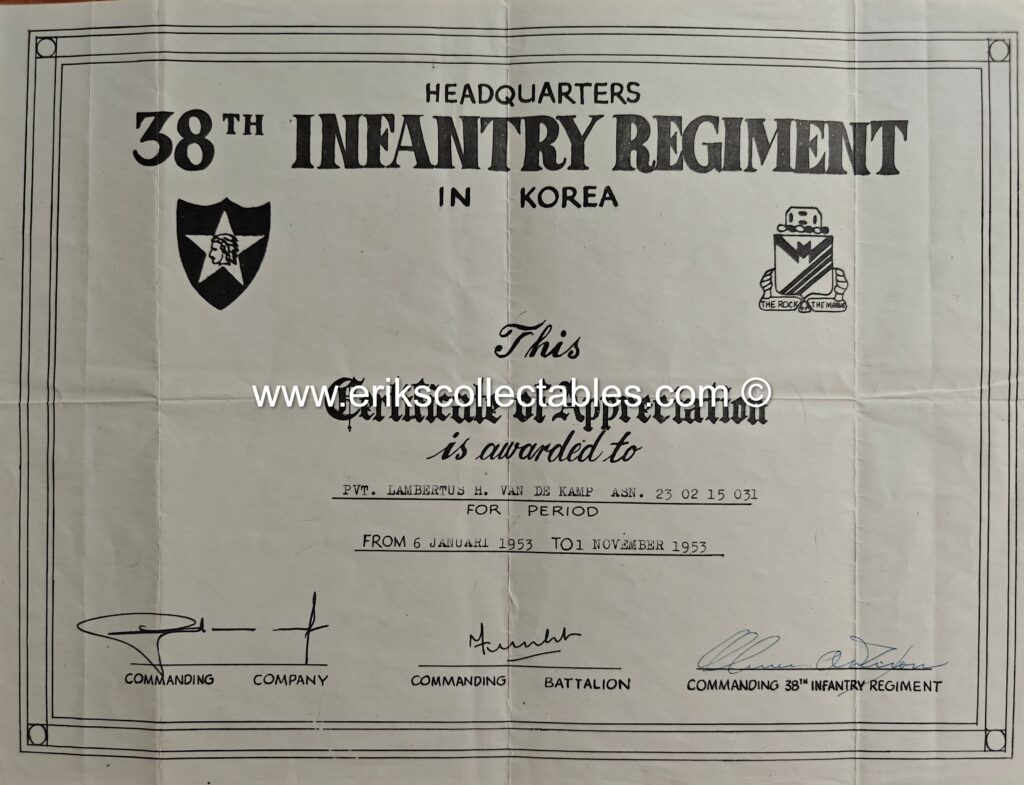
De “certificate of appreciation” werd alleen uitgereikt bij dienst naar tevredenheid.
Het is een feit dat hij voor zijn Duitse dienst gestraft is met een ontzegging om te dienen in de gewapende macht maar het is ook een feit dat hij dit wel gedaan heeft vanaf januari 1953.
Op basis van de hem toegekende medailles en de Combat Infantryman Badge blijkt dat hij zijn dienst eervol en naar behoren verricht heeft.
Ik heb meerdere Koreagangers onderzocht aan wie de medailles onthouden (niet uitgereikt of ingenomen) werden ivm straffen die zij kregen tijdens de diensttijd.
Dat kan soms gaan om relatief kleine vergrijpen, zeker met moderne ogen, zoals dronkenschap. Maar soms om zwaardere vergrijpen zoals het maanden lang niet terugkomen van het korte verlof in Japan (ongeoorloofd afwezig in oorlogstijd). Vaak is er niet direct te achterhalen waarom militairen gestraft werden.
Dit was bij Van de Kamp dus niet het geval, hij diende zonder bijzonderheden en kreeg zijn medailles als beloning voor zijn diensten.
Lees meer over de medailles en insignes van het NDVN in deze blog.
Bekijk de snapshots van Munnix in Korea.
Lees over de achtergrond van een oorlogsslachtoffer in Korea.
Of de inzet van de marine in Korea.
Bronnen:
CABR, inventarisnummer 94068, dossier 20000
Valk; Vechten voor vijand en vaderland
Hoogenboom; Van Feldgrau naar kaki en olijfgroen
Wervingsfolder NDVN; Mannen van stavast
https://nl.wikipedia.org/wiki/Nationalsozialistisches_Kraftfahrkorps
Nog enkele foto’s uit de groep
